

“I
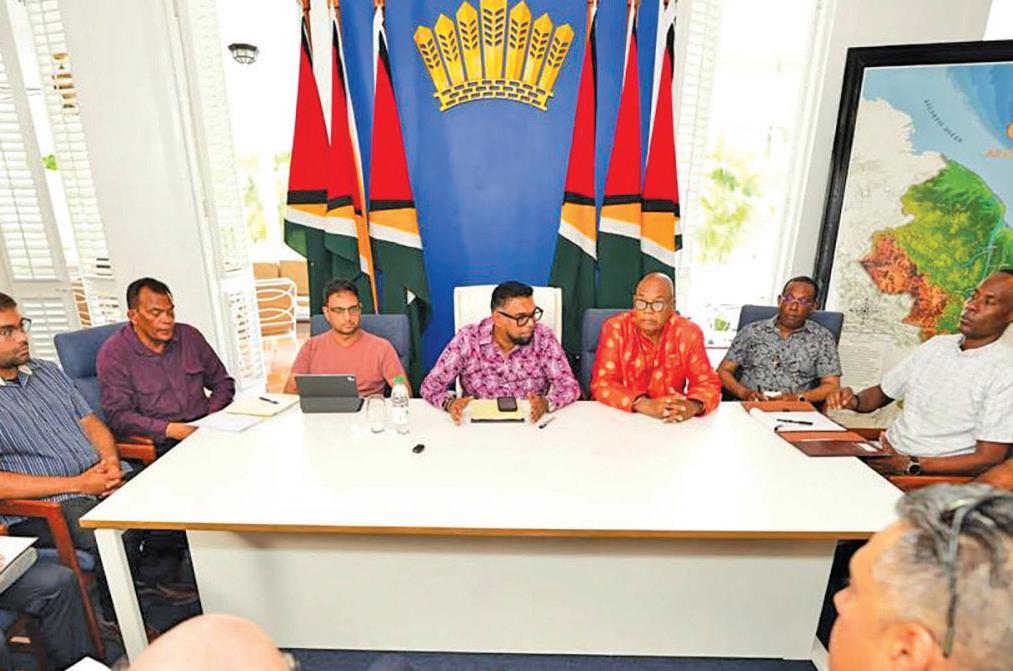
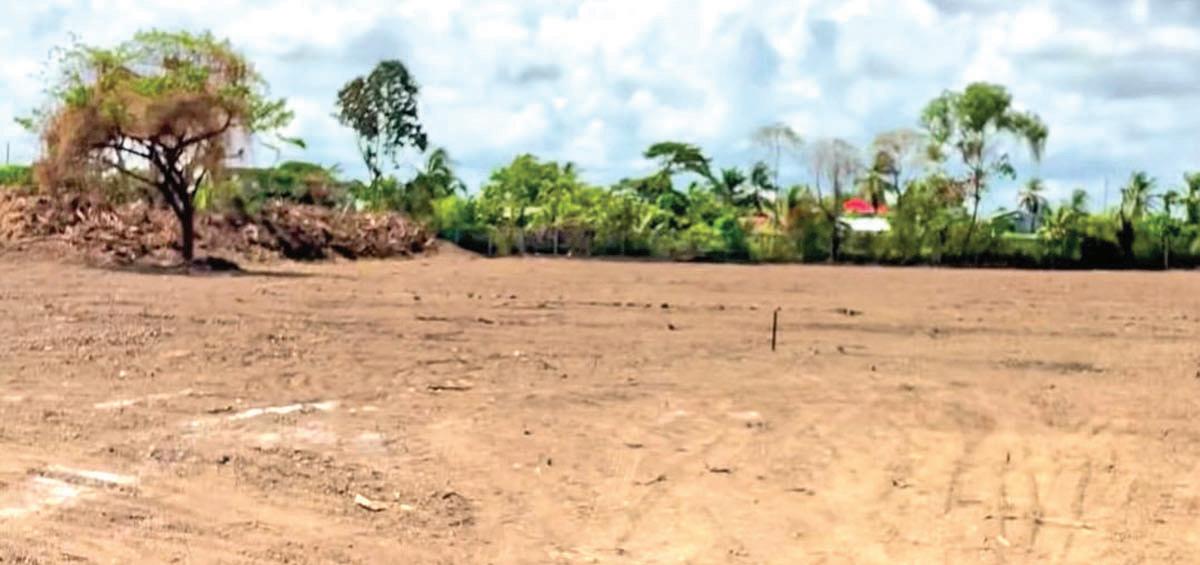


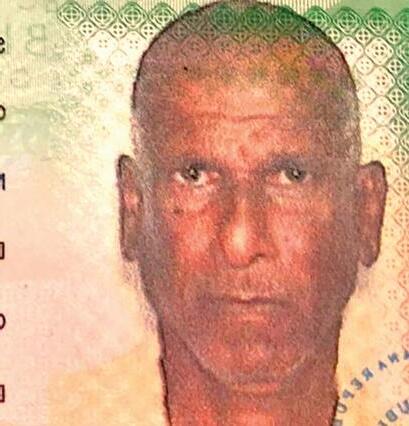
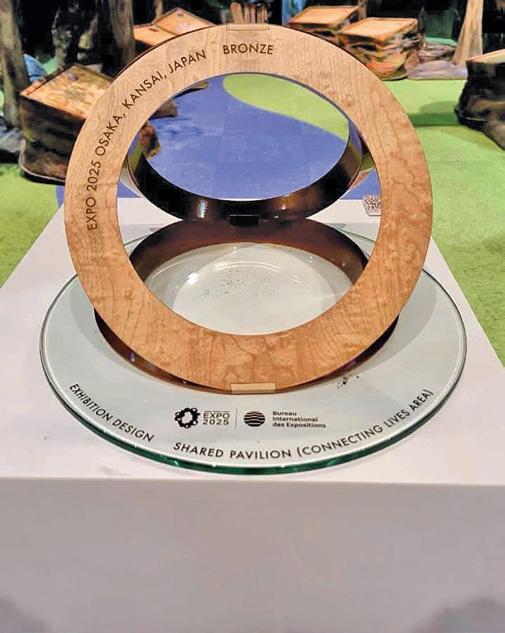
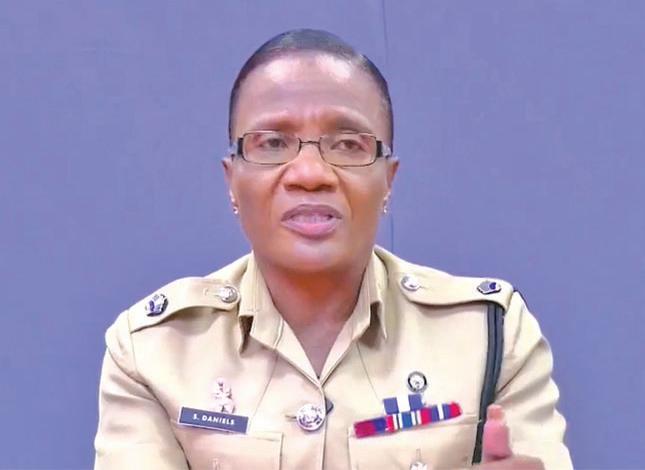


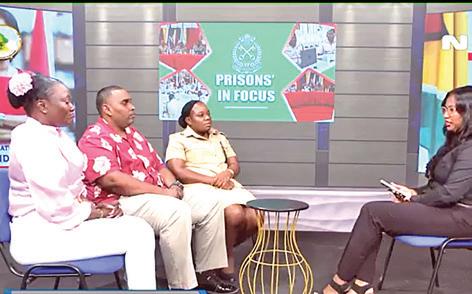
Essequibo Coast Praant welcomes Diwali season with “Deep Jale”





“I










Essequibo Coast Praant welcomes Diwali season with “Deep Jale”


The local Private Sector continues to bemoan the shipping delays from Trinidad and Tobago as a result of port congestion, with the Georgetown Chamber of Commerce and Industry (GCCI) warning of a possible supply-chain paralysis ahead of the upcoming Christmas holiday. In a recent statement over the weekend, the Chamber expressed deep concerns over the continued recurrences of shipping delays from the port in Trinidad’s capital of Port of Spain. Back in August, the Port of Port of Spain, the twin-island republic’s main port facility, was listed by shipping lines as the slowest port in the entire Caribbean. This, according to reports coming out of Trinidad, was due to the inefficiency of cargo and customs operations that have seen a backlog of vessels outside the port for as long as two weeks, far beyond their scheduled docking dates. According to the GCCI, however, this port congestion is an issue which has, over the years, resulted, in impediments to regional trade and hindrances to local supply chains.
“Members of the GCCI—particularly those within the manufacturing, trade, retail and construction sectors—have reported delays in receiving shipments of raw materials, as well as increased demurrage and storage costs, and disruptions to pro -
duction and project timelines.
This situation has not only disrupted operations but placed undue pressure on cashflow,” the Chamber noted in its missive.
The GCCI went on to call on both Guyanese and Trinidadian authorities, as well as the port operators, to address this issue immediately through strategic coordination. It underscored the critical need to prioritise essential cargo and restore efficient shipping operations. In fact, the Georgetown Chamber recommended the facilitation of alternative routing and expedited clearance to cushion the impact on the local business landscape and stands ready to work with regional partners and the private sector to implement practical remedial solutions.
“These actions are necessary as we reflect on the dire implications of such delays last December that resulted in supply chain disruptions and increased costs for consumers. We cannot afford a supply-chain paralysis ahead of the holiday season— swift action will limit economic harm to the business community and consumers,” the GCCI declared. Furthermore, it pointed out that there is a pressing need for the authorities in Trinidad to review the procedures and operations of their port facilities to ensure surety of regional trade and end repeated disruptions.
“Trade and stability cannot

be held hostage by inefficiency,” the Georgetown Chamber contended. Similar sentiments were recently expressed by the Guyana Manufacturing and Services Association (GMSA) in a statement last week, which stated that the ongoing port congestion and shipping delays in Trinidad have caused disruptions to both large and small businesses here. According to the GMSA, these challenges at the Port of Port of Spain have disrupted supply chains and created delays in the importation of key raw materials. It noted that for many local manufacturers and traders, these delays translate into higher costs, production
slowdowns, and loss of revenues.
GMSA President, Rafeek Khan, explained that both large and small manufacturers are being affected by the shipping delays, which have persisted for several months now and are causing a ripple effect in the costs of operations locally.
“We are having issues with manufacturing inputs because raw materials are being held up in Trinidad, affecting manufacturing for almost every scale of operations. It doesn’t matter whether you’re making pepper sauce, beverages, or butter; we have to import certain ingredients for the manufacturing process. And companies, as you can
imagine, when they run out of their raw material, have to stop their factories … So, we’re trying to find out what’s causing this [delay],” he noted.
Some authorities in Trinidad have cited issues such as massive congestion at the port, with many empty containers there; priority being given to other regional destinations over Guyana that are more lucrative; and the increase of larger vessels carrying larger volumes of cargo as possible reasons behind the hold on Guyana’s shipments. Moreover, the GMSA, in Thursday’s missive, also highlighted the impact this situation could have on local operations during the upcoming holiday season.
“The uninterrupted flow of goods is critical to ensuring product availability, price stability, and business continuity across multiple sectors. Strong, reliable regional logistics remain essential to the success of Guyana’s growing manufacturing sector and to enabling our manufacturers to be competitive. The GMSA, therefore, calls for a timely and coordinated resolution to the situation and reaffirms its commitment to national development,” it posited.
To this end, Khan indicated that they are looking to engage the Trinidadian Port Authorities as well as the Trinidadian Government to resolve the issue.



The Berbice Bridge will be closed to vehicular traffic on: Monday, October 13 –09:25h–10:55h and Tuesday, October 14 – 11:00h–12:30h.


Parika and Supenaam departure times – 05:00h, 10:00h-12:00h, 16:00h, 18:30h daily.




Sunny conditions are expected during the day, interrupted by midday thundery showers. Clear skies are expected at night. Temperatures are expected to range between 23 degrees Celsius and 33 degrees Celsius.
Winds: East North-Easterly to Easterly between 1.34 metres and 4.02 metres.
High Tide: 09:00h and 21:17h reaching maximum heights of 2.13 metres and 2.19 metres.
Low Tide: 14:44h reaching a minimum height of 1.16 metres.










“I am not going to tolerate it any more” – Pres Ali raps contractors, consultants over traffic woes
resident Dr Irfaan Ali
Pon Sunday read the riot act to the contractor, consultants and the local technical team working on the rehabilitation and expansion of the East Bank Demerara (EBD) Public Road, as well as the Guyana Police Force (GPF) over the miles-long traffic buildup on Saturday. As a result of ongoing construction works, sections of the two-lane road at Soesdyke, in the vicinity of St Mary’s, were closed off, resulting in only one lane of traffic being allowed to move at a time – causing major chaos along the upper East Bank corridor. During a meeting with the contractor, China Road & Bridge Corporation (CRBC); consultant, Sheladia Associates Inc; engineers from the Public Works Ministry and the GPF’s Traffic Department along with other stakeholders, President Ali, accompanied by Cabinet Ministers, upbraided the contractor and consultant on the pace of the project as well as the manner in which traffic arrangements are being followed. He cautioned them about the seriousness of the situation, the implications of delays, and what is expected of them moving forward in the timely execution of the project.
“It is clear to me that enough effort is not placed on traffic management and the workflow plan. And as a result, you are causing tremendous hardship on the people who are using this road, and I am not going to tolerate it any more… This is the last time I intend to speak to the contractor and consultant, because the consultant is equally to be blamed, as well as the site engineer from Public Works,” he contended. This is not the first time the Guyanese leader has had to meet with these stakeholders on the comprehensive management of this road project including the workflow plan. In fact, he had previously told the contractor to avoid closing off several sections of the EBD road simultaneously especially since this is a main thoroughfare that leads to the country’s hinterland regions and the Cheddi Jagan International Airport (CJIA) – Guyana’s main port of entry. At Sunday’s mid-afternoon engagement, the Head of State ordered that a system be put in place that will reduce, as far as possible, the difficulties to the commuters.
“We know there will be disruption, because it is
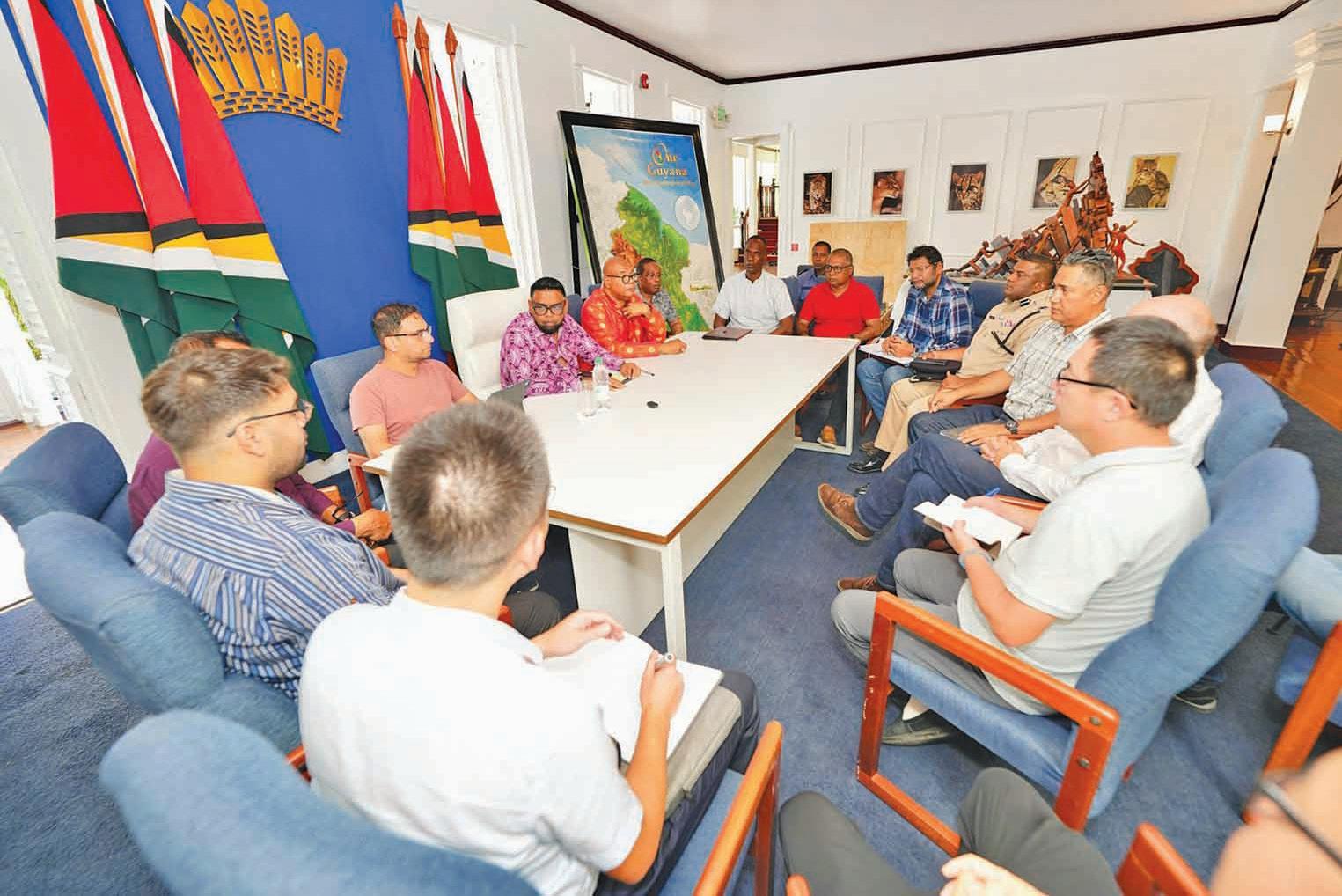
the only carriageway. But you are contributing to the difficulties that we are having… We are not going to accept the type of contract management that we have seen in the last four days,” he declared.
Revised work plan & consequences
To this end, the contractor and consultant were instructed to submit a revised work plan within 24 hours. According to President Ali, “There must be a clearly defined workflow plan and management that all the agencies are aware of. There is a serious problem
with the workflow plan… I understand the difficulty in building out on this one corridor, but there are ways in which we can mitigate some of the challenges. Concentrate on completing sections so that you don't have 10 and 12 sections that are creating the bottlenecks in the traffic management.”
The Head of State further went on to order the contractor to have more work done in the nights as well as increase the manpower on site to accelerate the pace of the construction. In fact, he cautioned that there could be conse-
quences if they failed to do this. “For this project to be completed and for less disruption to the commuters, you have to put the people in during the night, increase your machinery, increase your workforce. I said this more than one time. I hope that you will take the necessary corrective action to ensure that we don't have reoccurrence… [Otherwise] liquidated damages will be applied across the board, consultant, contractors, and everybody.”



Editor: Tusika Martin
News Hotline: 231-8063 Editorial: 231-0544, 223-7230, 223-7231, 225-7761
Marketing: 231-8064Accounts: 225-6707
Mailing address: Queens Atlantic Industrial Estate Industrial Site, Ruimveldt, Georgetown
Email: news@guyanatimesgy.com, marketing@guyanatimesgy.com
With our Opposition parties in disarray, the advice of a former Canadian politician and Harvard professor – gleaned from his two tenures on the practice of politics in a democracy – from the perspective of an Opposition Leader, is apropos:
“Opposition for opposition’s sake is the modus operandi of most parties out of power, but it is precisely the political “game playing” that active and attentive voters so despise, wishing politicians would support or oppose measures on merit alone. Realistically, legislators rarely decide measures on merit alone, and Opposition politicians generally oppose Government measures whatever their merits.
The Opposition’s duty indeed is to oppose and, through criticism and amendment, to make legislation serve the public interest. Government measures are put to the test of adversarial justification in committee and in the chamber itself. The Opposition is called “loyal,” to remind the public that, for all the venom of parliamentary debate, opposition is integral to the proper functioning of a democratic system. Indeed, it is in opposition that you are supposed to learn how to govern. In a functioning democracy, all parties in opposition properly deserve to be treated as a Government in waiting, though the Government in office and the media rarely do. In a free society, one would expect Government and Opposition to compete on equal terms. In reality, the media accord the Government a platform the Opposition can only envy.
One of the defining features of a proper democracy is that it must “normalize” and “naturalize” disagreement, for it is through structured disagreement that democracy arrives at its rough-and-ready version of the public interest. Adversarial justification is democracy’s chosen method for establishing the public good. If so, opponents are supposed to accept each other’s basic loyalty and legitimacy.
Democracy is, or ought to be, a politics of adversaries, never a politics of enemies. An adversary today is a potential ally tomorrow. An enemy can never become an ally. An enemy is to be destroyed. The politics of compromise is impossible unless the Opposition enjoys the status of loyal and legitimate adversary.
Democracy, being a system of structured antagonism, must find ways to contain the emotions that antagonism inevitably arouses. The representative function demands restraint in the face of the temptation to think of politics in the metaphors of war, as a battle in which no holds are barred.
When adversaries grapple for power, it is only too easy to treat each other as enemies. A democratic politician has to keep asking himself whether, in his attack on an opponent, he has crossed the line that separates legitimate public criticism from mendacious advantage seeking. In the heat of the moment, the line can be hard to discern, let alone respect. Winning at all costs becomes a self-sufficient justification. Where democracy has gone under, as in Weimar Germany, the politics of adversaries was replaced by a politics of enemies, and politics soon spilled out of the legislature into the streets, where violence soon settled all questions.
Democracy has proved its resilience but at a cost. Public disenchantment with excessive partisanship is nearly universal in the United States, Canada, and the United Kingdom. For a considerable portion of the active democratic public, “politics” itself has acquired a bad name. The word has degenerated into a term of abuse for any form of spiteful, dogmatic, rhetorical game playing whose essential purpose is to obscure rather than reveal the essential public issues at hand. Nevertheless, democracy itself does offer a remedy for excessive partisanship. Electorates relish combat and they like fighters, but they frequently punish those who hit below the belt, and by sanctioning bad behaviour at the polls voters help ensure that democratic combat remains a contest between adversaries, not enemies. Indeed, we should add this to our original list of essential conditions of democratic health. Democratic representation works when institutions control corruption, when debate is sufficiently truthful to allow democracy to address society’s real problems, when a culture of public service survives, and finally when democratic opponents treat each other as adversaries, not as enemies.”

By Dr Amit S telAng, mD HigH CommiSSioner of inDiA to guyAnA
On 10th October, we observed the World Mental Health Day and on 11th October, we joined hands to mark the International Day for the Girl Child. Both of them highly relevant, the reason being our tendency to treat them as mere rituals of ‘Days and Years’.
There is nothing wrong in observing these days and years. They are crucial in creating awareness. But they should not become part of event calendars and instruments in the hands of marketing mavericks using them as symbolic gestures. We have colourful ribbons and flags displayed, beautiful wristbands flaunted, and glossy-looking stationery bought in the name of charity. It might be essential because a good number of people might be willing to pay for them to help the cause, remaining unaware of the gravity of such issues. At least they are willing to empty their deep pockets, someone would argue! Granted, but between awareness and awakening, there is still a long bridge to cross.
Mental health is quite complex because of the stigma attached to it. Celebrating a girl child is definitely more complex than a simplistic construct of equality, opportunities, and rights. There are many common misconceptions and the bias becomes built-in. In
case of physical disability, we are far more forthcoming compared to mental health issues. The canvas of mental health issues is so wide and the stigma so deep-rooted that we tend to either underestimate the challenge or tend to brush it under the carpet as an unpleasant truth.
A girl child is celebrated in some societies and some homes, and yet birth of a son is no less than a phenomenon in a majority of homes. Boys are supposed to be strong and girls are supposed to be pretty. This emphasis on beauty undoubtedly blunts the potential. From a young age, it is firmly engraved that girls must be pretty and boys must be strong. Unfortunately, economic development and progress hardly change such stereotypes. Even in highly-developed countries, the beauty barometer determines the altitude of success for a girl. The process begins in the family and the society reinforces it.
In the case of mental health, too, the family and society tend to reinforce the belief that talking about mental health issues is a sign of weakness. In the case of boys, it may pose questions about their masculinity, while for girls it is treated as an ‘intrinsic sign of feminine softness’. Imagine the mental makeup of a person suffering from a mental health issue in a society where discussing this issue is a sign of weakness. Even though there are multiple self-help books and counselling options, they
can seldom replace a strong family and societal support structure. The solution invariably lies in the family and the community.
I am impressed to witness a lot of phenomenal work towards this end in Guyana. While family structure might have further scope for reinforcement; at the community level, many organisations have undertaken commendable work that requires both appreciation and emulation. I am told that in Guyana, mental health issues continue to be a pressing concern. It is true in almost every society.
Regarding perception about a girl child, too, I would imagine, to be a situation not much different from other comparable developing societies. It is equally important to appreciate that in a multi-cultural, multi-ethnic and multi-religious society like Guyana, a single solution might not be able to address the situation or offer a magic remedy. But it is an issue worth pondering over – not only for the Government, but for society as a whole.
Even before I came to Guyana, I was aware of the Guyana Hindu Dharmic Sabha and its impressive work at the community level. Their work received recognition in the form of the Pravasi Bharatiya Samman – India’s highest recognition to non-resident Indians – for their exemplary community work. Earlier this year, the Saraswati Vidya Niketan, too, received the same honour for their commendable community work.
In both these cases, creating conducive atmosphere in a community has been a model to appreciate and emulate. I have no doubt that there are several other community-based organisations, across Guyana’s multicultural spectrum, that continue to contribute towards this cause. Guyana’s churches, mosques, and temples as well as other community-based organisations continue to play a significant role in creating cohesiveness and offering community-based solutions to complex issues.
But the process has to begin at the family level. The family continues to be at the core of long-term transformation. A strong family structure acts as a building block for providing guidance and support during ups and downs in our lives. In a non-functional family, for reasons beyond control of an individual, the community has an even bigger role to play. A family and a community should consciously think about the stereotypes and unique societal requirements. Every society has a different requirement based on its structure, its built-in biases and perceived role models. In the name of progress, an external model need not be superimposed on an inherently complex society. Such a model evolves from within the society. As any society progresses, it is but natural that its interactions with other societies increase, in turn influencing each other’s outlook.
Dear Editor, President Dr. Mohamed Irfaan Ali reminded Guyanese that, “leadership is not about power or prestige but about service and sacrifice.” As the successful incumbent PPP/C government at the recently concluded Regional and General Elections held on 1st September 2025, the President has mixed, matched and manoeuvred ministerial management
as cabinet administrators.
The 13th Parliament is yet to be called but all the ministers are up and running and the same is expected of the recently appointed regional councillors. Will they be tasked with changing the image of public concerns, complaints and chagrins?
This new five-year term of PPP/C management is crucial and they can ill-afford déjà vu to be on the menu.
As the newly appointed Local Government and Regional Development Minister, the Honourable Priya Manickchand is saddled with harnessing the RDC’s, NDC’s and the Municipalities to create “models of good governance and service” to ensure that, “national priorities are translated into tangible benefits for citizens.”
For too long this has been a sore and sour sit-
It is under such situations that fissures develop in existing societal structures and a tendency to be self-critical becomes rampant. But the society leaders play a crucial role in salvaging such situations. The onus is on them to guide the society and channel the energies in the right direction. It is in this endeavour that a family plays a crucial and indispensable role as a community unit. It helps to adapt and guide. It determines the velocity and volition of change.
The change, therefore, must begin at the family level. We call this process ‘Family Awakening’. It is not a sudden change or a response to a crisis. It is a slow transformation – deliberate, gradual, and thoughtful. There are multiple facets to it. A harmonious society remains the top-most priority. But along with that, issues like sustainability and service become indispensable. One important tenet in this process is that such a change begins from ‘Self’. Therefore, self-awareness is a key to community and social change. Thinking beyond the ‘Self’ and understating it in the interest of the society also becomes es-
sential.
In this construct, speaking about one’s problems should not be discouraged but approached with an objective outlook. Such intervention is extremely crucial at a younger age, but it is not entirely irrelevant as one grows old. It is not about a young child or a teenager facing identity issues. It is, in fact, relevant at all stages of life and certainly not restricted to any particular gender. Such family awakening would not begin unless the community and the society appreciate that a strong family structure is necessary for an optimally functioning community and society – and therefore a Nation. While individual growth is important, the willingness to appreciate and work towards a broader cause need not be underestimated. In the same way, we must accept that economic growth per se would not ensure societal transformation. It requires a conscious effort and a spirit of cooperation, collaboration, and co-existence.
In so far as growth and development of a girl child is concerned, the equality parameter is pivotal. But working on re-

moving unconscious biases based on beauty, emotions, motivation, and strength also require a conscious effort. It might be natural to believe that a son emulates his father and a daughter follows her mother. But it is essential to reinforce that for a family to succeed, both are indispensable and a son can learn from his mother and the daughter would be inspired by her father. A brother, a sister, a grandfather or a grandmother also are the building blocks for such mindfulness. A supportive family can do wonders, it can awaken an individual, a community, a society, and a nation.
Don’t we need such an awakening? Isn’t it about time that we go beyond the days and years...?
uation which has stigmatised the urban and rural areas where, “shared commitment to the people’s welfare, and to the advancement of the region as a whole,” has been found wanting and lacking. The Minister wants to know, “where they (RDC/NDC) work, where they don’t and why…..”
The tough, robust and no-nonsense minister is mandated with a rigorous schedule for the next five years to execute much needed changes. The lackadaisical attitude, lack of initiatives, the absence of proactive interests, poor public relations, and unheeded responses are some of the minimal ineptitudes which are worrisome for immediate engagement and eradication.
His Excellency, Dr. Ali, urged public officers who are servants to the people of Guyana to “remain mindful that public office is not a prize to be enjoyed, but a trust to be honoured.” Blue- and white-collar crimes have become cancerous in all communities in all the regions. Corruption has criminalised the provider and receiver and enhancements and enticements have encouraged inducements for “expedited efficiency.”
In his inaugural address after being sworn in office for a second term, President Dr. Irfaan Ali

emphasised: “Every official will be required to account for their personal assets and anyone who cannot do so will face the full force of the law. We will pursue both the corrupted and the corrupters, leaving no room for impunity.” With a people-centric transformative roadmap for Guyana, all anti-corruption agencies will have a full-time job tasked to confirm transparency and accountability for efficiency, fairness and credibility of the public service.
Interesting days and nightmares are ahead for the Public Accounts Committee and the PNC with Chairman of the PAC, Jermaine Figueira resigning from the PNC, and APNU becoming the Minority Opposition after winning only 12 seats. WIN captured 16 seats to unshackle (usurp?) the reign from the PNC to become the Leader of the Opposition.
This will be the first
time in the history of Guyana’s Parliament that another party other than the PPP and the PNC will occupy that seat! Who will head the PAC? The PNC is already refusing to step down from GECOM as the three Opposition Commissioners. PPP/C and PNC have outsmarted WIN to keep them out from regional leadership in Regions 8 and 10.
Guyana’s politics and policies are experiencing shifting sands as the boat is being rocked by an unfriendly sea of challengers. Time and tide will be tampered with temptation, intimidation and solicitation. But President Ali cautioned Guyanese that, “it is through humility, empathy and integrity that true leadership is defined.” Will Guyanese leadership be moulded by this advice?
Yours sincerely, Jai Lall


MONDAY, OCTOBER 13, 2025
00:00 Sign off 06:00 Cartoons 07:00 Week-in-Review (RB) 07:30 Cartoons 08:00 Stop Suffering
Movie - Togo (2019) 10:30 Movie - Flipped (2010) 12:00 News Break 12:05 Movie - Newsies: The Broadway Musical (2017) 14:30 The Fairly Oddparents 15:00 How I Met Your Mother S5 E3 16:00 KTLT Kids Today Leaders Tomorrow (RB) 16:30 Indian Soaps 17:00 The Young & The Restless 18:00 Anthony Bourdain Parts Unknown 19:00 The Evening News 20:00 Misadventurers Finale
9-1-1 S5 E6 22:00 House of Cards S2 E2 23:00 Power Book II: Ghost S4 E1



You’ll need: Pebbles Craft paint Black permanent marker
Step 1
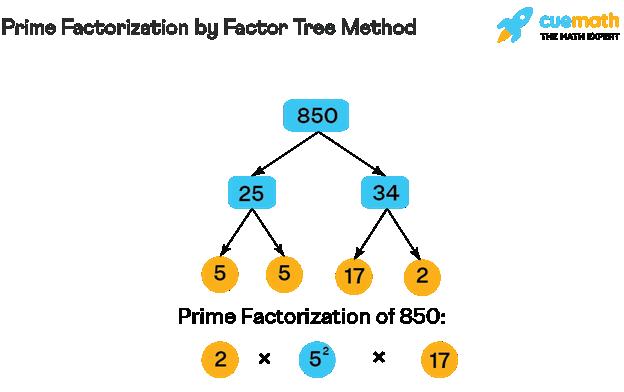


Instructions:
Take your chosen pebble and decide where you want to place the heart. Press your finger into the paint and place it at an angle on the pebble, and then repeat at the opposite angle, to create the two curves of the heart. Leave to dry.
Step 2
Using a black marker, write your friend's name on top of the heart.


You may want to cover the pebble with varnish or waterproof sealant if you are going to place them outside. Your friendship pebble is now complete!(hobbycraft.co.uk)


By Louise Bogan
I burned my life, that I might find A passion wholly of the mind, Thought divorced from eye and bone, Ecstasy come to breath alone. I broke my life, to seek relief From the flawed light of love and grief.

With mounting beat the utter fire Charred existence and desire. It died low, ceased its sudden thresh. I found unmysterious flesh— Not the mind’s avid substance—still Passionate beyond the will.

Start or end a short story with a character looking out at a river, ocean, or the sea.







The clearing of vegetation from the eight-acre plot of land identified for the construction of a Council of Legal Education (CLE)accredited law school in Guyana has been completed in preparation for construction works. At his September 7 inauguration ceremony following the recent General and Regional Elections, President Dr Irfaan Ali had disclosed that Guyana received approval from the CLE to pursue the highly anticipated project, and noted that work will commence immediately. Two weeks later, Attorney General (AG) and Legal Affairs Minister Anil Nandlall, SC, accompanied by Vice-Chancellor of the University of Guyana (UG) Professor Paloma Mohamed, Christopher Ram and other UG officials, visited the site earmarked within the university’s Turkeyen Campus for the country’s first law school building. The clearing of the lands, which were heavily vegetated, commenced shortly after and has since been completed. On Sunday morning, AG Nandlall conducted a site visit to inspect the preparatory works done at the location that will house the main building and other facilities relating to the Caribbean’s newest addition to its current complement of law schools.
“The land itself is eight acres…it was heavily overgrown with vegetation, bushes – a jungle basically, and we commissioned the clearing of the land and the land is now cleared,” he stated during the visit. Located at the southwestern section within the university’s compound, a road had to also be built to access the site. “There's a road that we had to clear to come into [site location] because UG has reserved the front part of the lands for other purposes. So, we are at the back [and] we had to clear a road to access the back,” AG Nandlall stated, adding that “…we will start construction very shortly.”
The AG had previously told the Guyana Times that
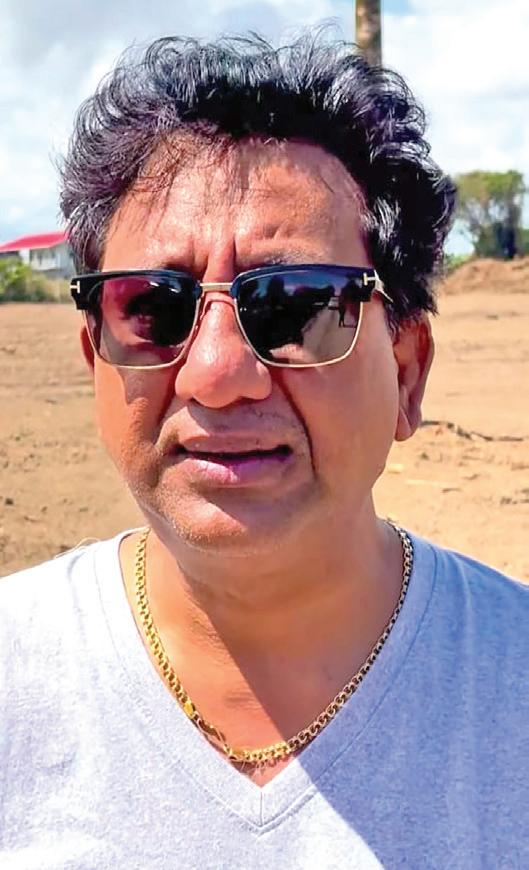
funding for the law school will be included in the next budgetary cycle, and thereafter, the procurement process to select a contractor will commence.
Meanwhile, the plan and architectural design of the new law school are already drawn up and were part of the proposal that was presented to the West Indies’ CLE and approved.
Plans for local law school
Over the last two years, the People’s Progressive Party/Civic (PPP/C) Administration has been working to get permission from the CLE to establish a much-needed law school here. The CLE is a regional organisation which operates the Hugh Wooding Law School in the Republic of Trinidad & Tobago, the Norman Manley Law School in Jamaica, and the Eugene Dupuch Law School in the Bahamas. Guyana had previously conducted a feasibility study for the establishment of a local law school, and the findings were handed over to the CLE last September. Additionally, a high-level subcommittee, which included AG Nandlall and other prominent officials across the Caribbean region, was appointed to review Guyana’s application.
For nearly three decades, Guyana has been trying to establish a law school within its jurisdiction since Guyanese law students are forced to attend the Hugh Wooding Law School in Trinidad.
However, only the 25 top law students from Guyana are allowed each year into the programme. UG’s Law Degree programme usually has about 40 students per year. Moreover, the high cost of living in Trinidad has deterred many persons from further pursuing a legal career, but in response, the Guyana Government now offers limited fully funded scholarships to Hugh Wooding Law School. The journey to getting a local law school set up here started some three years ago when Guyana’s proposal to set up its own law school was accepted by the CLE in September 2022. The CLE subsequently outlined the requirements that the country needed to fulfil, including the conduct of a comprehensive feasibility study in which Guyana has to illustrate the number of students the school will attract and accommodate as well as the Government’s capacity to fund the construction of the facility and its initial operation cost.
Under the previous A Partnership for National Unity/Alliance For Change (APNU/AFC) Coalition Administration, attempts were made to establish the Joseph Oscar Fitzclarence Haynes Law School. However, the CLE was not approached about the project initially, and when permission was eventually sought, it was denied in late 2017. But the PPP/C Government, from the inception, had declared that any law school that is established in Guyana will be done under the ambit of the CLE – something that will also allow the country to capitalise on the overcrowding at the other institutions across the region.
In fact, Nandlall, speaking during his Issues in the News programme last Tuesday, contended that, “…It's a regional institution. But of course, we take great pride in having that type of institution within our country, and obviously this will bring investments to Guyana. It will bring people from all over the world. It will enhance our reputation and resume
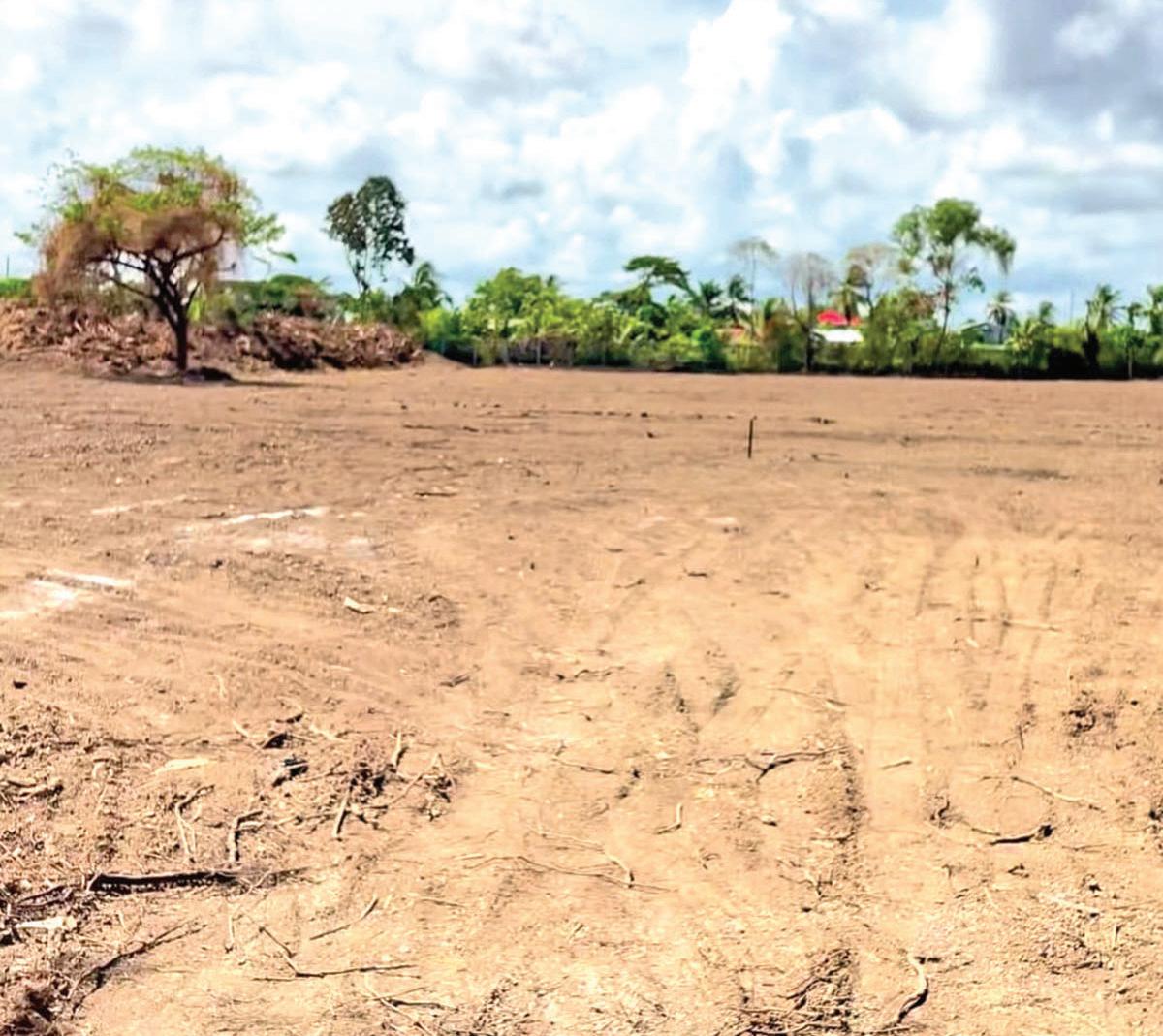
as an education destination, and you have heard our Government articulate its vision in this regard. So,
the law school project will proceed with every convenient speed and hopefully in the shortest possi-
ble time, we will be able to open the doors of the law school.”
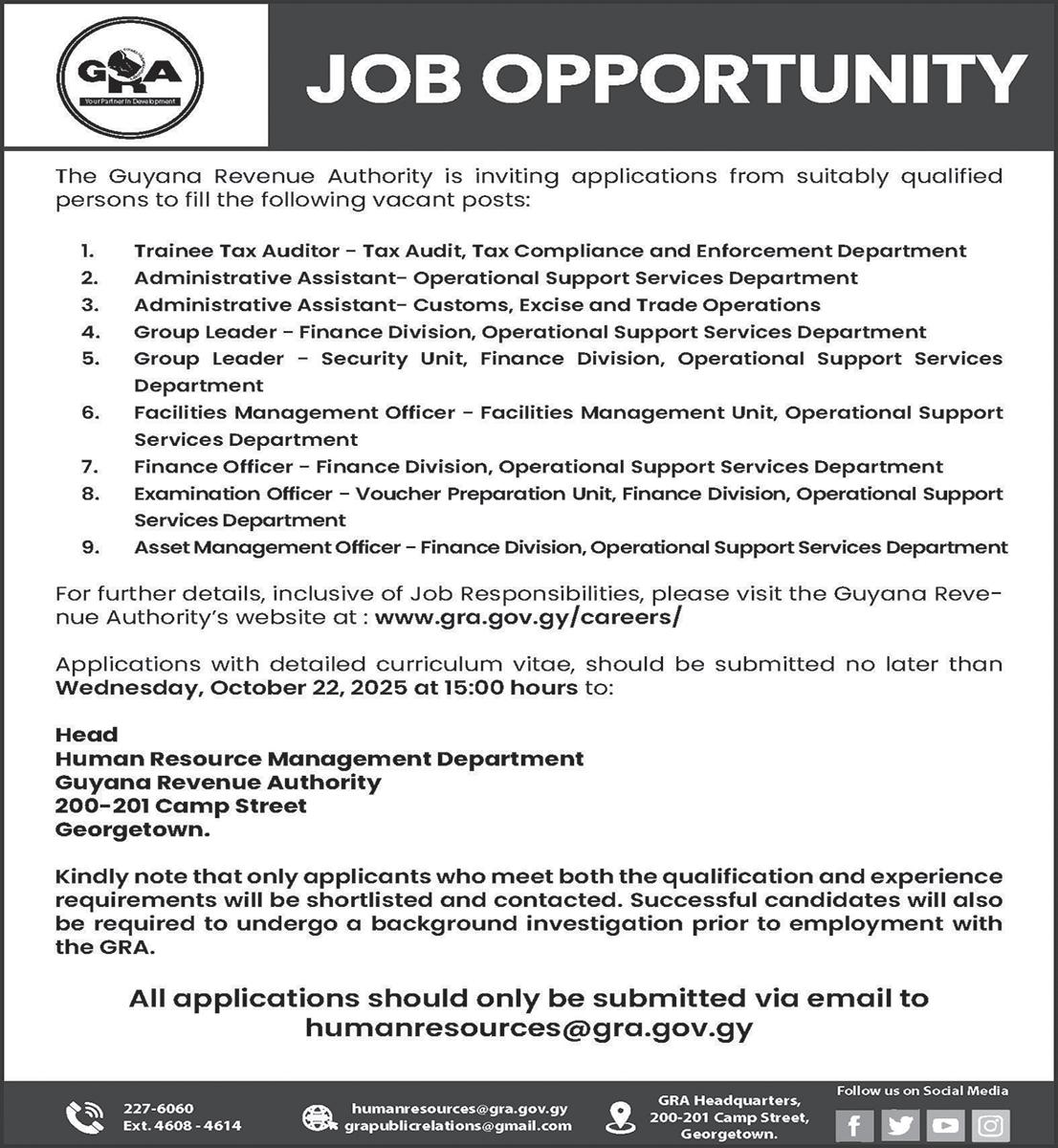





Some of you Dear Readers might think your Eyewitness got Mad Maduro on his mind…and you’d be right!!
‘Cause while most of our attention has been focused on our internal political contretemps, Mad Maduro might just decide to create what for him would be a diversion –by attacking us. Let’s not forget he has a precedent since Venezuela launched a surprise attack against us back in 1966 when they seized our half of Ankoko Island. And most importantly, there’s been absolutely NO repercussions!!
We don’t even talk about Ankoko no mo’!! Shouldn’t we invoke Venezuela’s illegal occupation of our territory at every opportunity?? Like at the UNGA and UNSC – as Mad Maduro had the temerity recently to whine about American “intrusions” in the Caribbean Sea!! We gotta launch a “Free Ankoko” programme domestically and internationally immediately. Your Eyewitness is all for the protests on Gaza – but with the ceasefire, can’t these worthies now pour their energies into a “Free Ankoko” movement??
Having been convinced that we’re walkovers – but scared shi*less of the Yanks raining Phoenix Missiles on Miraflores Palace!! – Mad Maduro might very well use proxies to attack us. Externally, there’s the violent semiofficial Sindicatos – who exist through the connivance of his military in their “Mining Crescent” adjoining our Essequibo across the Cuyuni River! They’ve attacked our GDF patrols several times in the last few years. These were exploratory feelers to gauge our response – which have unfortunately been limited to firing indiscriminately across the Cuyuni and into the dense forests where the Sindicatos blend in.
Your Eyewitness thinks it’s high time we become more proactive in taking the fight to Mad Maduro!! Maybe by using those five high-tech, long-endurance drones Granger and Ramjattan bought at the (exorbitant) five times the cost of drones with similar specifications back in 2019?? The War in Ukraine has been all about drones dropping bombs on enemy installations, innit?? Back then the Granger regime – with his phalanx of military types – made your Eyewitness think they were preparing us to be a high-tech small nation like Israel – to take on the big, bad bully next door!! Maybe this might be the catalyst for the Yanks to move their operations from the sea to land?!!
The other Mad Maduro proxy we gotta watch out for are those “sleepers” or “fifth columnists” we must take for granted he’s embedded amongst the thousands of Venezuelans who fled his dictatorship and imploded economy. Remember those Venezuelans who planted explosives at that GPL sub-station off Mandela Ave?? And blew up that gate of the nearby E. La Penitence Police Station?? We gotta initiate a comprehensive programme –covert and overt – to suss out these “refugees”!!
Offence is the best defence!!
…Haitian gangs
Some time ago, your Eyewitness had noted with great interest the vociferous intervention of some Opposition types when a number of Haitians – who were being trafficked into Brazil – had been intercepted by the law. The proud history of Haiti in leading the first successful slave revolution in the world – to gain independence – was invoked. And the need to assist this pioneering nation for freedom was raised.
Well, the UN Security Council has again approved a motion for increased support for the force headed by Kenya that intervened to bring some order to that benighted land that’s being held hostage by armed gangs. Caricom had been asked to provide some manpower to back up the Kenyans and Bahamas and Jamaica had stepped up to the crease –albeit rather modestly. The US financed the initiative.
But your Eyewitness had expected the Opposition defenders of Haitian freedom would’ve come out by now to demand that our government send some troops to assist.
Are they not our brothers?
…(obstructionist) loitering
Now that the BJDRB’s been launched, your Eyewitness observed a strange phenomenon. GTowners and East bankers now (leisurely) sightseeing across the span from dusk to midnight!!
And now making life hell for West Siders who now take 1 hour to cross!!


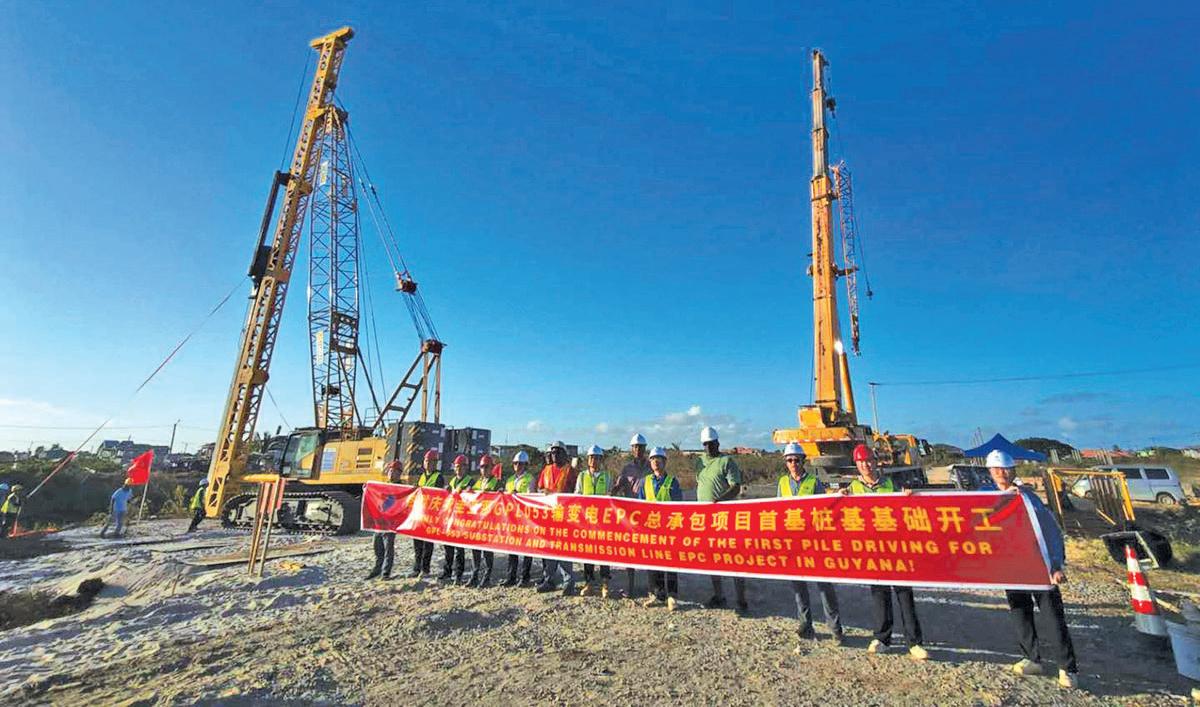
Almost two weeks after President Dr Irfaan Ali ordered that works be fasttracked to relocate the Guyana Power and Light Inc (GPL) transmission lines along the Railway Embankment on the East Coast of Demerara (ECD), pile driving works have commenced. “Pile driving has begun along the Railway Embankment, East Coast Demerara, to install new 69 kV (kilovolt) transmission lines that will replace the old network and improve electricity reliability,” the Head of State said in a social media post on his Facebook page. These works are part of the US$192 million East Coast Road Expansion Project from Sheriff Street,
Georgetown, to Orange Nassau on the East Coast. The new four-lane roadway along the Railway Embankment was initially slated to be completed by October 30. However, there have been challenges with the relocation of utility properties especially the GPL transmission lines along the ECD corridor. During his October 1 visit to the site, President Ali instructed that efforts will be undertaken by GPL to start the relocation works immediately. With some of these utilities having to go on a completely new alignment, he added that the contractors should take advantage of the good weather conditions.
“They have to start driving piles out there [and]

cast all of the base. You have the sunshine now… In this weather, they should finish all the pile driving and all the base [or will they] wait until the weather change to do that,” Dr Ali told officials on-site earlier this month. The full relocation of the transmission lines onto the new alignment in the backlands along the ECD corridor has a three-month deadline.
According to the Head of State, the relocation of utilities is being paired with major upgrades to the power system, ensuring that new developments along the East Coast corridor are fully integrated into the grid. These include the Enmore Industrial Zone, the La Bonne Intention (LBI) commercial/light in-

dustrial hub and surrounding housing schemes.
New developments
During the visit, it was revealed that the US$192 million project from Sheriff Street to Mahaica was some 77 per cent completed.
“This is the contract of the four-lane road expansion from Mahaica all the way to Sheriff Street… From all that we’ve seen today, physical works are about 77 per cent completed,” the Head of state had noted. Part of this project includes the construction of the new Hope River Bridge, which the Guyanese leader indicated was almost finished. At 99.2 per cent completion, the outstanding works in-
clude expansion joints, street lights, painting, and the laying of the final asphalt layer.
Once completed, this bridge will connect to the larger four-lane road corridor stretching from Mahaica to Sheriff Street via the railway embankment. The new Hope Bridge now carries four lanes, complementing the existing two-lane structure along the main ECD corridor, giving a combined six-lane crossing that will still be in use. “Looking ahead of us, Mahaica going all the way to Rosignol is the next phase of development. Most of the design has been completed there also,” he added.
The Guyanese leader had further disclosed that almost all lanes from Mahaica to Good Hope have been surfaced, with only the utility-occupied sections left to be done. “We’re not completely satisfied with the pace of work. But some of it is outside of the hands of the contractors,” President Ali said, noting that “this project will come to completion very soon.”
The President’s visit was on the heels of massive buildup of traffic for several days, due to the ongoing construction works, especially during rush hours, with persons complaining of being stuck in traffic for hours along the East Coast corridor.
But once completed, this four-lane project is expected to significantly reduce traffic congestion along the East Coast, improving travel times and road safety for thousands of commuters. Additionally, the residents that concerns over access to their yards have been resolved, with new entrances already rebuilt.
In December 2022, the Government and the People’s Republic of China signed a Framework Concessional Loan Agreement for US$192 million to finance Phase II of the East Coast Road Project. The project forms phase two of the Annandale to Mahaica and Sheriff Street to Orange Nassau initiative. It measures approximately 30.8 kilometres (km) in length, with an additional 5.3 km allocated for the upgrade and widening of the Belfield to Orange Nassau public road.
The works include upgrading Sheriff Street to Enmore from two lanes to four, covering 18.24 km. New construction will take place from Enmore to Mahaica. This section spans 7.73 km. The project also involves the construction and widening of 76 bridges and 42 culverts, along with the installation of 28.32 km of concrete drains on both sides of the roadway.


Victims of domestic abuse in Guyana are being urged not to stay silent or fear retaliation, as the Guyana Police Force (GPF) continues to strengthen support mechanisms for those seeking protection under the Family Violence Act of 2024.
During an episode of Police and You, Superintendent Shellon Daniels said that victims no longer have to appear in person at a police station to make a report, as calls can now be made through the domestic violence hotline—914—or directly to any police station. “You don’t have to go in person to make the report,” Daniels explained. “It is encouraged that you make the report. You could call any police station.” She noted that reporting abuse is the first crucial step toward obtaining a protection order and breaking the cycle of violence. Victims can start the process through a phone call, after which the Police are required to respond and assist with the necessary steps.
However, Daniels acknowledged that some victims hesitate to report out of fear that the perpetrator might find out before they can complete the process. She encouraged them not to be deterred, reassuring them that while the Police must confront the accused, the goal is protection—not
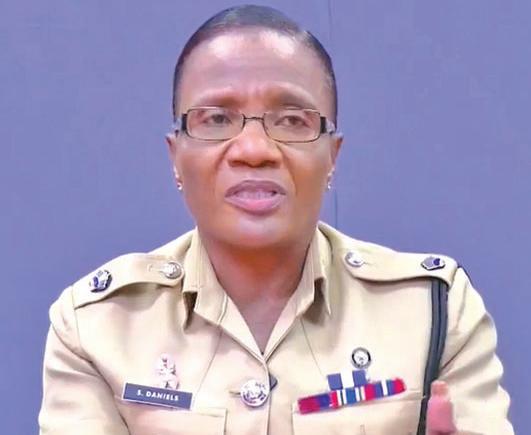
exposure.
“Once a report is made to the police station, there is a process,” she explained. “Automatically, the perpetrator will be made aware… but that should not deter you because at the end of the day, you make the report— the Police must confront the perpetrator and deal with the matter as the law mandates.”
Public Relations (PR) Officer Stan Gouviea agreed that awareness is key, noting that many victims are unaware of their right to seek immediate assistance and legal protection. Daniels reminded viewers that the police can also file for protection orders on a victim’s behalf, provided they give consent. “A police officer under the Family Violence Act…
has the authority to assist you in applying for the protection order, provided that you give them consent,” she said. The Superintendent also advised victims to keep in touch with police officers handling their case and to ensure that any issued order is properly served and lodged at the nearest station. “Having applied and successfully issued with this order, be it a temporary or interim order, it is your duty to take it to the closest station,” Daniels emphasised. Her message to the public was that help is available, and no one should suffer abuse in silence. “Make the report,” she said. “Once you recognise that you have been abused one way or the other, take action. The police are there to help you.”

“I am not going

“We will put a system in place to avoid what took place two days ago. And if the contractor can't get it right, I'm going to ask the AG (Attorney General Anil Nandlall) to examine the terms of contract and have you dealt with… I want to make it very clear. It is absolutely clear that you have to put more machinery and more human capital to accelerate this work,” the President stressed.
As a result of the ongoing roadworks at Soesdyke on Saturday, there were miles of traffic buildup along the EBD road. Despite efforts by the GPF’s Traffic Department to manage the orderly flow of vehicles, some motorists were overtaking and creating several lanes of traffic, which worsened the situation.
In fact, several social media posts with photos and videos shared by frustrated members of the public captured outgoing passengers walking with their luggage from as far as Land of Canaan along the East Bank corridor in a bid to reach the CJIA on time for their flights.
Several persons even missed their flights. Moreover, some airlines were forced to reschedule their departure times after their crews were also stuck in the traffic.
Traffic management interventions
In a traffic advisory on Sunday morning, the Police Force indicated that the road works are still ongoing along the East Bank corridor between Supply and Soesdyke.
As such, the GPF stated that “…outgoing passengers via the CJIA are advised to factor delays into their planning to get to the airport on time for check-in. Motorists are reminded that their actions must not lead to obstruc-

tion or delays; practice the 5 Cs of defensive driving and support safe progression of traffic. Report errant drivers who are not compliant, do not follow them.”
However, during Sunday’s meeting, President Ali called for stricter measures to be implemented as he highlighted to the Police the blatant disregard for traffic rules and road safety, particularly by trucks.
On this note, a number of measures were agreed upon, including the establishment of an integrated control room and the implementation of a traffic management drone system.
“All the trucks [and other vehicles] that are breaking the rules, forming three lanes and four lanes, you have to charge the drivers… The role of the Police is to support the smooth flow, to support the safety measures, and we have to deploy our technology to help with this. Move the control room closer to the corridor [and have] 24/7 monitor by drones. Identify those who are breaching the traffic laws and those who are contributing to safety risks, and let the law take its course,” President Ali declared.
In addition, an Early Warning System (EWS) and an emergency transport plan, in collaboration with the Guyana Defence Force’s (GDF) Coast Guard and the Marine Section of the Police Force, will be set up also to help manage traffic and the workflow, as well as assist persons heading to the CJIA in cases of unforeseen circumstances, henceforth.
“We have different docking areas going all the way to Timehri. So, we must have an Early Warning System, especially for persons going to the airport. If there is an unforeseen circumstance, that system must kick in. The Coast Guard must kick in. The boats will be in place. We have the boats so we can help people to get to the airport during this phase of construction.”
“[But] the contractor must be responsive to the Police. Two days ago, there was total miscommunication. The contractor was not responsive, [while the Police were] trying to get pieces of equipment out of the way. There must be coordination, teamwork, and precision in getting this work done,” the Head of State contended.



The Guyana Hindu Dharmic Sabha, Essequibo Coast Praant, officially ushered in the season of Diwali on Saturday evening with its annual “Deep Jale” celebration at the Anna Regina Town Council compound, Anna Regina, Region Two (Pomeroon-Supenaam).
A breathtaking structure depicting Goddess Lakshmi, created by members of the Essequibo Coast Dharmic Naujawan Youth Arm, now stands proudly in front of the compound. The intricately designed and brightly illuminated display has become a major attraction for residents and visitors alike as the community prepares for Diwali – the Festival of Lights. The ceremonial lighting of the symbolic diya was performed by Morning Glory Inc Office Manager, Indrawattie Natram, who was joined by Regional Chairman, Devin Mohan, and members of the Dharmic Sabha.
Morning Glory Inc served as the main sponsor of the event, which
featured a vibrant cultural programme showcasing traditional dances, songs, and performances from young talents across Region Two (Pomeroon–Supenaam). Delivering brief remarks, Regional Chairman Mohan praised the Essequibo Praant for keeping the tradition alive and emphasised the festival’s message of peace and togetherness.
“Diwali brings joy, light, and spiritual upliftment...It is also a time to strengthen bonds among our people. Let us continue to let that flame of unity and love shine bright throughout our communities.” he said. He reaffirmed the Regional Democratic Council’s (RDC) commitment to supporting cultural and religious observances that promote inclusivity and preserve Guyana’s rich heritage. Meanwhile, Pandit Kaydar Persaud, President of the Essequibo Coast Praant, explained that Deep Jale meaning “to light a lamp” symbolises the illumination of

both homes and hearts. He noted that the tradition was introduced years ago by the Guyana Hindu Dharmic Sabha to inspire
coming activities leading up to the grand Diwali motorcade. Sponsor representative Indrawattie Natram expressed her company’s

munity. Our company is based right here, and this is our way of giving back to the people who continue to support us,” she said.
Jale celebration will be followed by the Annual InterSecondary School Rangoli Competition on October 15 at Abram Zuil Secondary

collective celebration and national unity. Extending warm pre-Diwali greetings, Pandit Persaud urged residents to take part in the Praant’s up -
pleasure in being part of the celebration for a second consecutive year.
“Morning Glory Inc is proud to support an event that brings joy to our com -
At the end of the evening, attendees received complimentary packages of Morning Glory cereal, adding a sweet touch to the festive event. The Deep
School, and the much-anticipated Grand Diwali Motorcade on October 16, 2025, at the Anna Regina car park.


MONDAY, OCTOBER 13, 2025|
The Guyana exhibition team at the Expo Japan 2025 will bring home a bronze award for exhibition design under the sub-theme “Connecting Lives” in the Shared Pavilion category of the event. President Ali, in a Facebook post, extended his congratulations to the team for winning the award. The Bureau International des Expositions (BIE) Day Ceremony of Prizes and Awards at Expo 2025 Osaka, Kansai, Japan was held Sunday, during which recipients of the Expo 2025 Official Participant

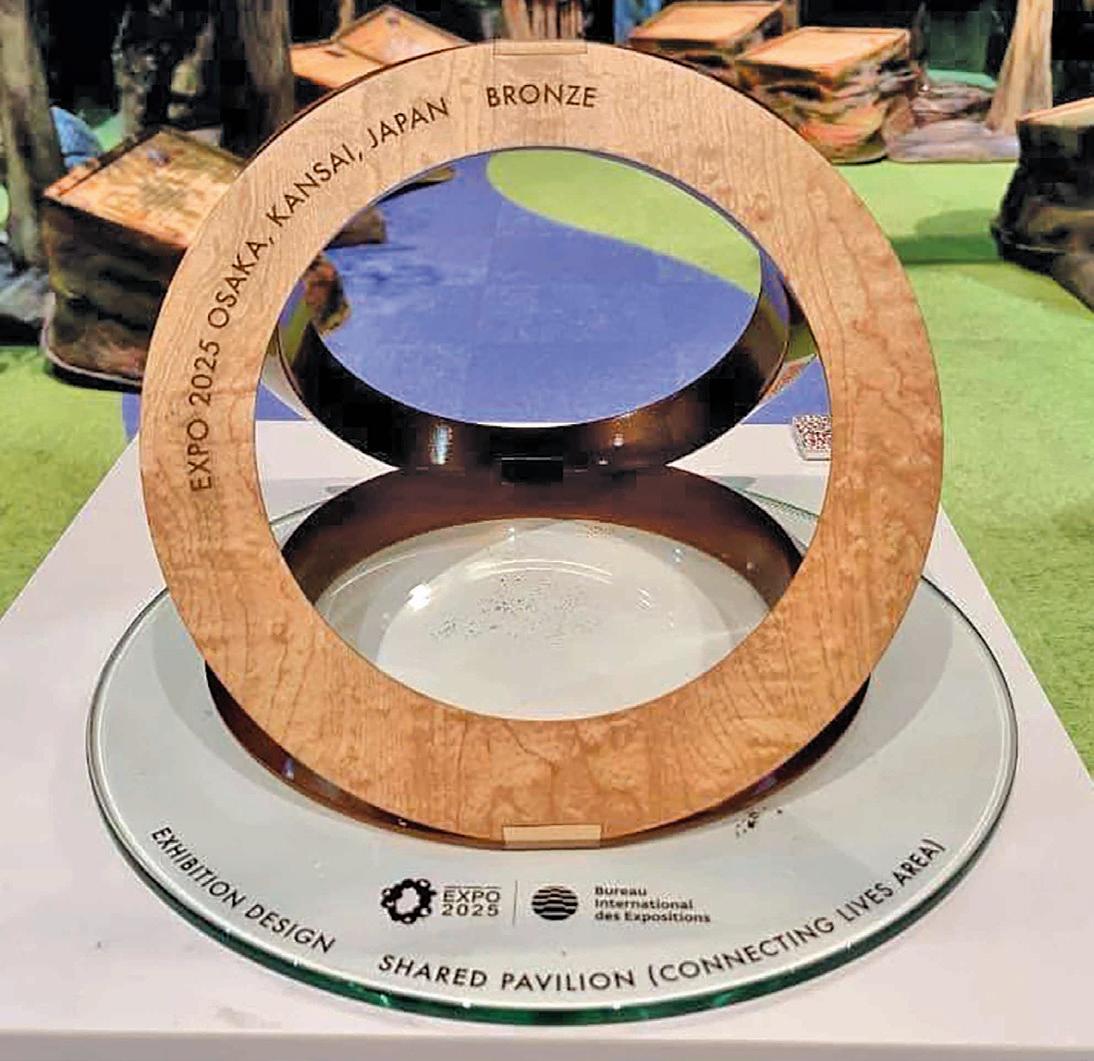
Awards were announced.
Guyana was one of 90 countries that participated in the Shared Pavilion category. A total of 165 countries, regions and international organisations participated in Expo Japan 2025. According to BIE, the recipients of the Official Participant Awards were decided by an international jury composed of nine experts in a range of relevant fields. The jury visited each international pavilion at Expo 2025 Osaka Kansai during the course of two sessions, in May and October 2025. Attributed in line with the diversity of pavilions according to their size and type, the Official
Participant Awards recognise various aspects of pavilions: architecture and landscape (for self-built pavilions only), external design (for module pavilions only), exhibition design and theme development, and sustainability.
A total of 45 Gold, Silver and Bronze Awards and four Sustainability Awards were handed out during the ceremony, which took place in the Expo Hall – Shining Hat.
The Expo took place on a 155-hectare site dominated by the Grand Ring, the largest wooden structure in the world with a circumference of two kilometres within which international pavilions are
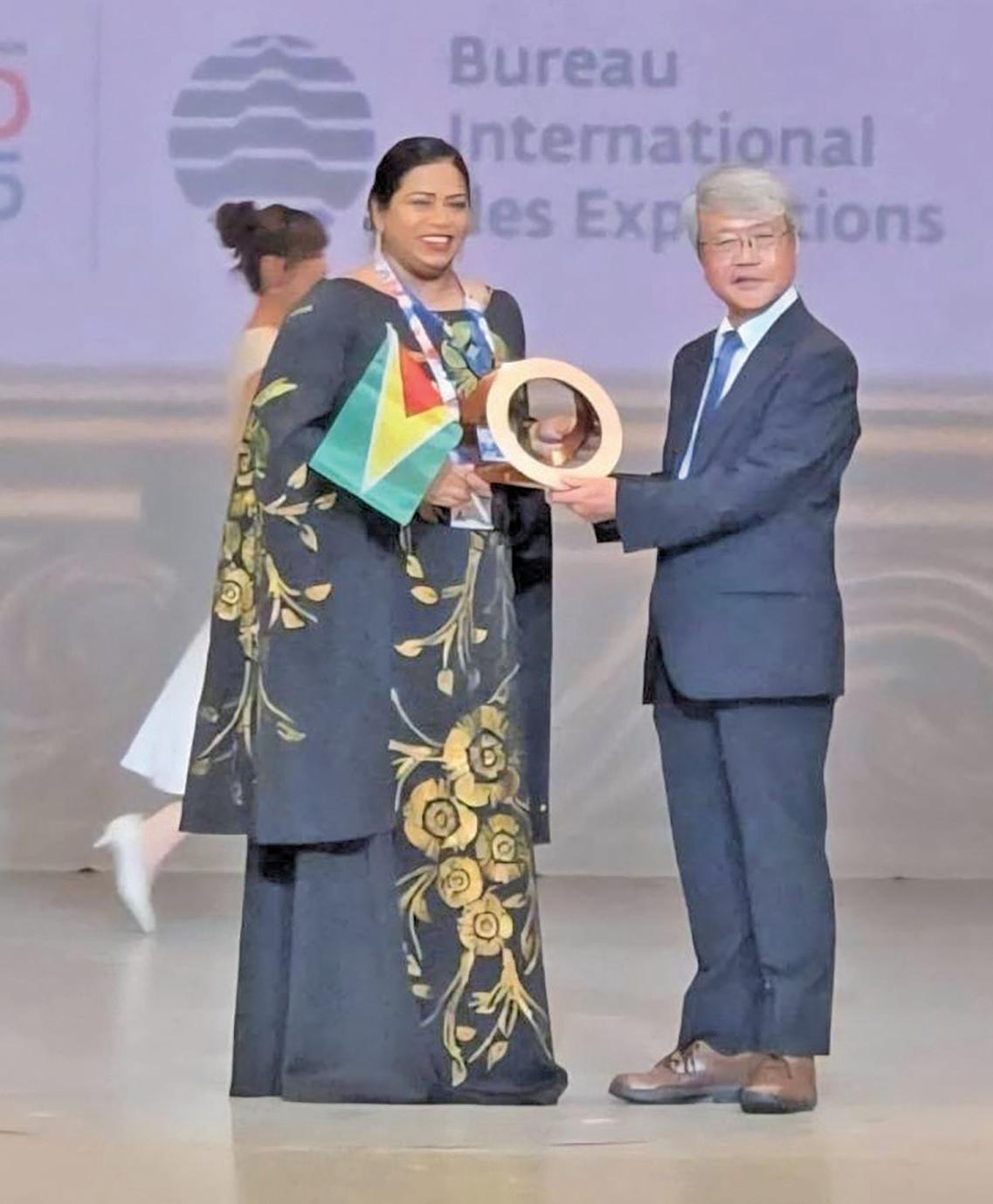
located. Pavilions were situated in one of three districts reflecting the Expo’s subthemes: Saving Lives, Empowering Lives and Connecting Lives.
Shared Pavilions (Type C), were a type of exhibition space where multiple participants can set up their displays within a common area. The “Connecting Lives" subtheme is said to be a core part of the expo's focus on fostering connections be -
tween people, ideas, and cultures to build a better future. The pavilions located in the "Connecting Lives Zone" are specifically designed to align with this concept.
The exhibition, under the main theme "Designing Future Society for Our Lives", ran from April 13 and closes today, October 13, 2025. The Gold award in the category went to Benin and Silver to Armenia.
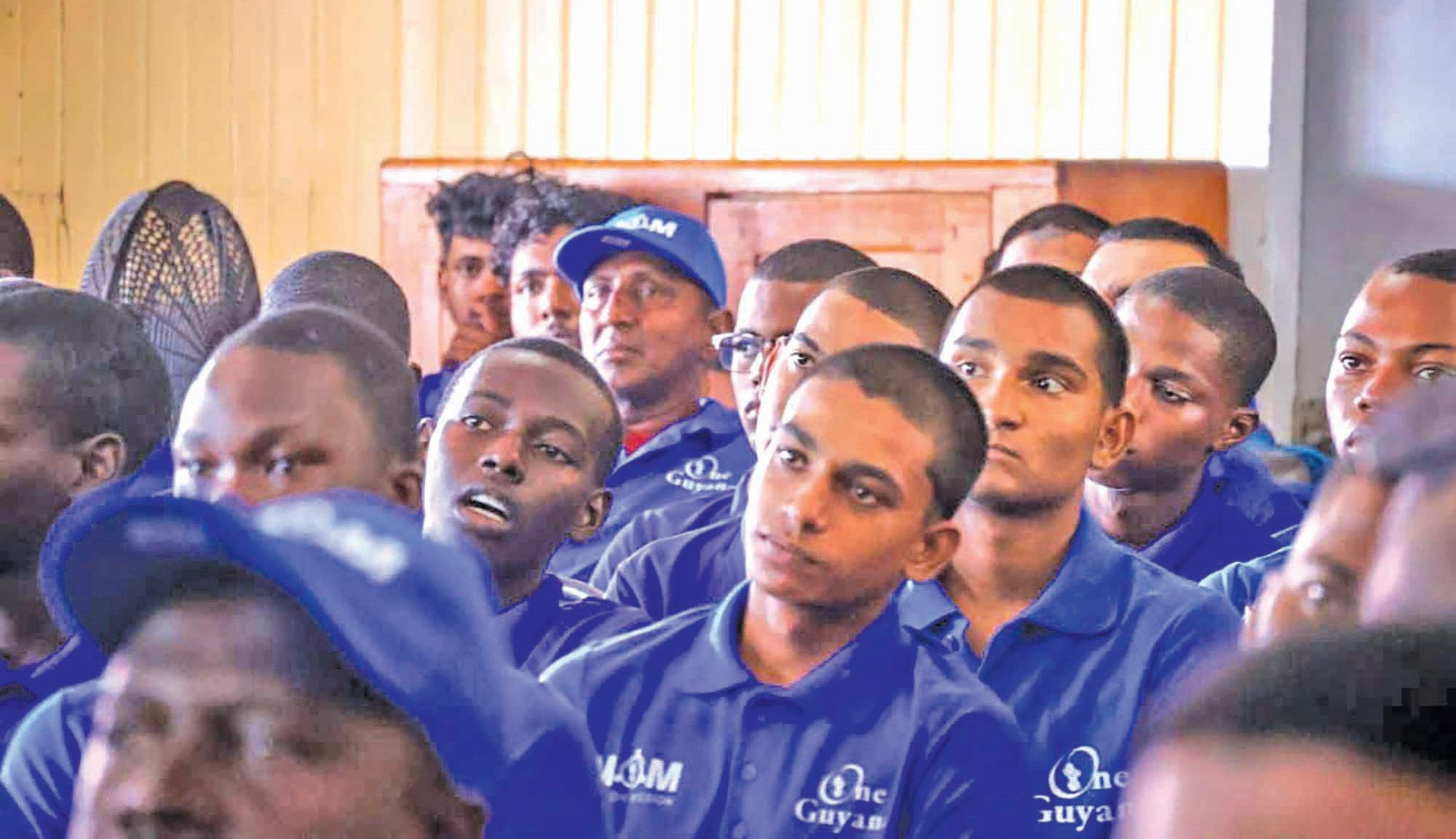
The Ministry of Labour and Manpower Planning participated in the first-ever Men on
Mission (MoM) Village Visit held Saturday in Albion, Region Six.
According to the
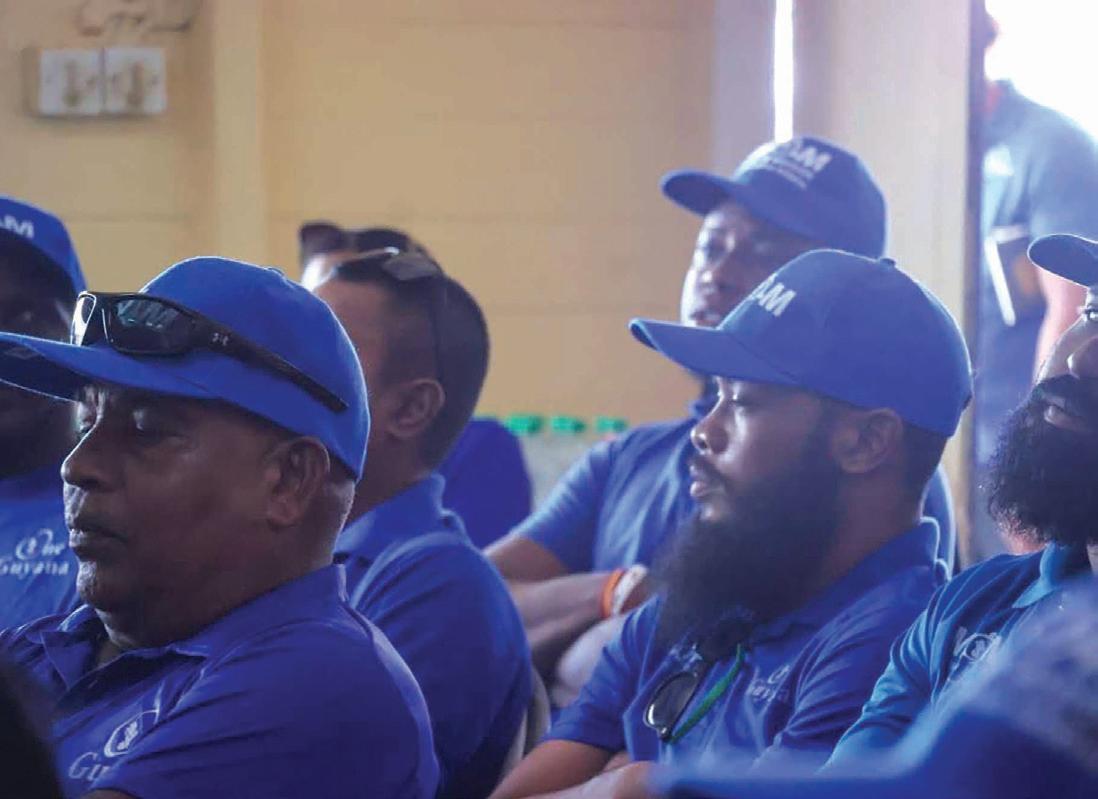
Ministry’s social media post, the initiative, held at Albion Sports Complex Ground, was aimed to bring men together to build stronger families and communities, promote positive role models, and encourage open conversations on men’s health and well-being. The event featured cricket and dominoes competitions, along with free medical check-ups for prostate, mental, and general health, assistance from the Ministry of Housing, and job placement and skills training opportunities through the Ministry’s participation. Present at the event were Chief of Defence
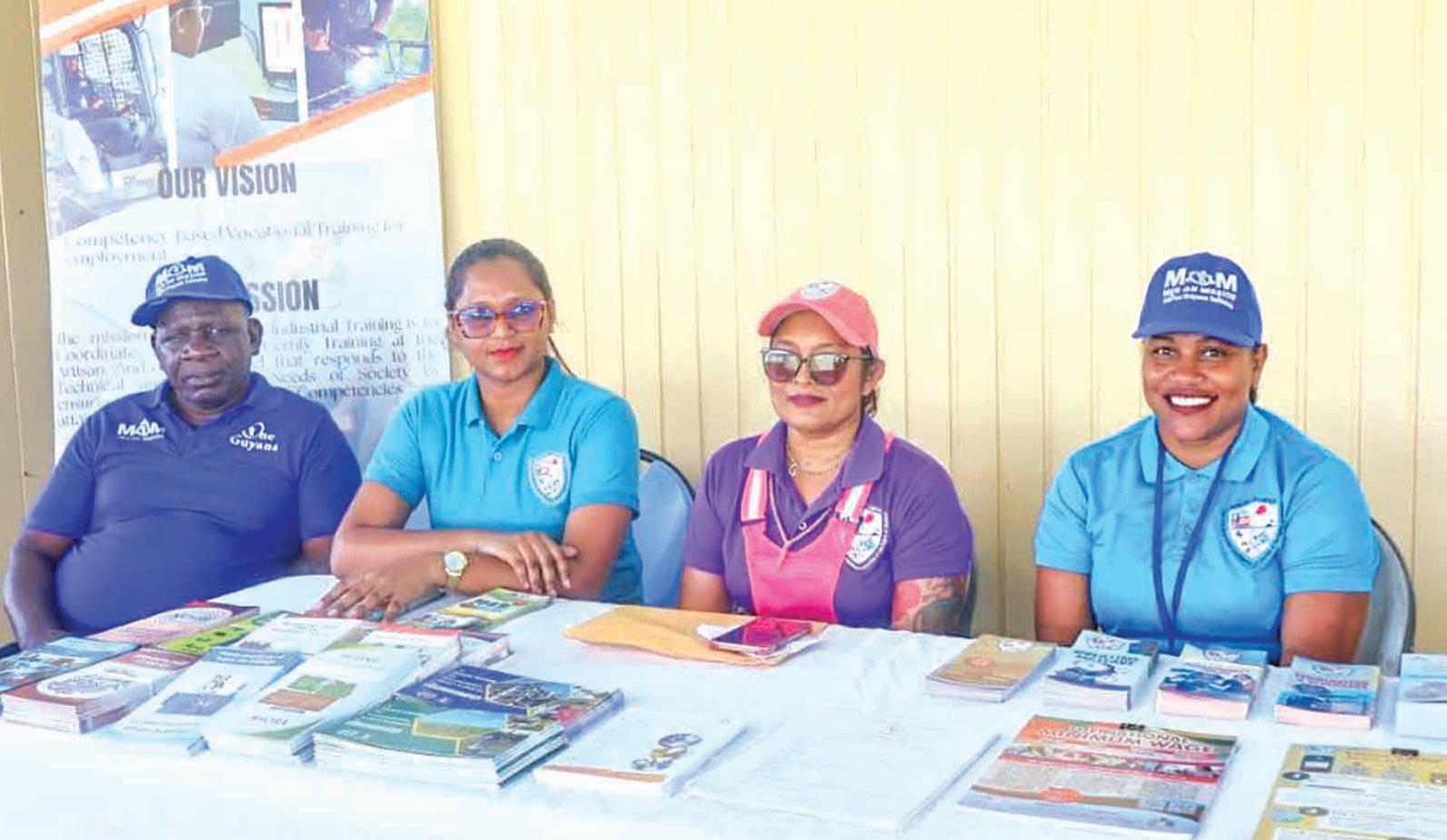
Staff and Chairman of MoM, Brigadier Omar Khan; Deputy Permanent Secretary of the Ministry of Local Government and Regional Development, Dr Josh Kanhai; Coordinator of MoM, Lieutenant Colonel Bhageshwar Murli; along with other officials.
Launched in 2022, the MoM initiative is the brainchild of His Excellency Dr Mohamed Irfaan Ali. It seeks to uplift the younger generation of men who face societal challenges such as drug abuse, domestic and gang violence, and other related issues.
The programme also of-
fers guidance and counselling, recreational and fitness activities, and promotes economic empowerment through temporary employment opportunities.



As part of a series of events being held around the country to observe October Agriculture Month, a ruminant expo was staged in Region Five (MahaicaBerbice) on Sunday. It was the first such event to be organised by the Guyana Livestock Development Authority (GLDA), a sub-agency within the Ministry of Agriculture.
The expo catered to farmers and agribusinesses, attracting participants from the five coastal regions, as well as Region Ten (Upper DemeraraBerbice).
The event featured a
tunity to share knowledge, access improved animal genetics, and strengthen market linkages.
Chief Executive Officer (CEO) of GLDA, Dr Dwight Waldron, explained that it allowed farmers to showcase some of the genetics which they would have from either breeding or acquired through the genetic improvement programme, which the GLDA is currently pushing with the aim of growth in the industry.
This, he pointed out, is not only applicable to large-scale farmers but also to medium-scale farmers throughout the country.
our genetic improvement programme and have benefited from breeding stock, artificial insemination, or embryo transfer. From what I’ve seen here today, our genetic improvement programme is a clear success. We are working with cattle farmers across the country to develop the beef industry, and from the Ministry’s standpoint, we’ve been working with a company from Brazil to develop our farm in Ebini, where we are concentrating on dairy. Soon, we’ll commission a state-of-theart abattoir at Onverwagt, and you know we have to ensure we produce enough

ruminant judging competition, where farmers competed for more than 20 prizes across various categories, recognising the best of Guyana’s cattle, sheep, and goats.
Genetic improvement programme
Farmers were also exposed to a livestock auction, which provided the oppor-
Minister of Agriculture, Zulfikar Mustapha, at the event declared Govt’s genetic improvement programme a clear success.
“In the livestock sector, we’ve been moving rapidly. I’m very impressed with what I’ve seen here. These animals are not the GLDA’s animals. These are farmers’ animals. Farmers who’ve worked with us in
meat for that facility. Based on what I’ve seen here today, if very impressive because it shows that over the last five years, we’ve exceeded our target as it relates to the number of animals that are available,” he explained.
Small ruminants
As it relates to small ruminants, there has been
a lot of talk and seemingly focus on the Barbados Black Belly sheep. Guyana was able to acquire 1000 of the animals from Barbados to boost the local stock, but Dr Waldron revealed that while Guyana now has the largest single flock of Barbados Black Belly in the Caribbean at the Guinea Livestock Station, the Barbados Black Belly is critical in terms of its adaptability and does not produce enough meat to grow the industry to the level that the GLDA is seeking.
“So we are going to be using those to lay the foundation. They are go-
ty that is certified internationally. We don't or we're not developing a two-tier system for our local consumers. What is good for the export market is just as good for the local market. We want to ensure that Guyanese have access to the best.”
The veterinarian who leads the GLDA in promoting and developing Guyana's livestock sector through initiatives like genetic improvement said they are using the Barbados Black Belly Sheep as a base because it is a tropical breed and has adapted to our conditions.
those are the synthetic breeds which give the meat a better marbling, a better quality.” According to Dr Waldron, the GLDA is also using the as part of the programme but to a limited degree. He said they are promoting the Girolando heavily. “Which is a mixture between Holstein and Brahman, and that was developed in Brazil. India did some work on that breed also. So based on our embryo programme that we have nationally, that is what we are pushing,” Dr Waldron revealed.
He pointed out that the Girolando breed has adapted to local conditions and
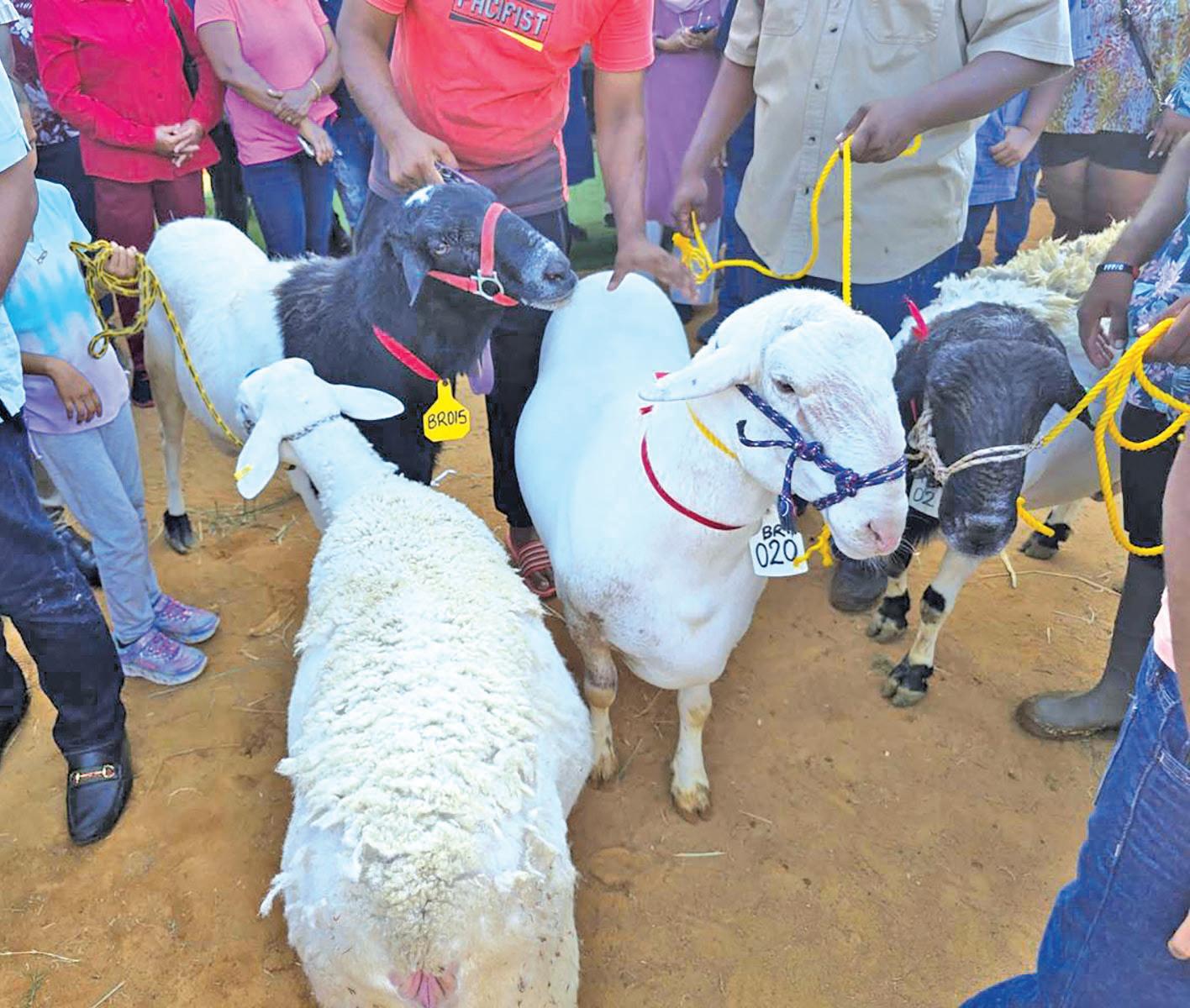
ing to be the foundation stuff for Guyana because we can replicate and multiply them quickly. We also have the black-haired Dorper, we have whitehaired Dorpers, and we have Katahdin here. Those are the meat breeds which we will be doing the crosses with Barbados Black Belly to ensure that we have the meatiness,” Dr Waldron explained. The Barbados Black Belly over the years has proven to be very good in terms of multiplying.
“Today, you won't get the meatiness from those. So come next year you will see we will be making some additional investments in ensuring that we have the processing aspect for small ruminants included in our strategic plan execution which is to ensure that the farmers can gain enough by selling not just quality meat but they can start looking at specialised cuts and so on and that can only be had from having a facili-
Meanwhile, the GLDA is currently focusing on both a dairy programme and a beef programme for the cattle industry. Currently, there is a bull rotation programme that would have seen the Government importing sixty-four bulls to supply the demand nationally. There are currently twenty-one breeders with which the GLDA is working on the programme. “They are the ones who are helping us to do the breeding, so that we can have animals available for all the farmers throughout the country. The base breed with which we are working with is Brahman. We are also working on feedlots in all the regions. That programme has already started, so for the animals that will be incorporated into the feedlot, we are crossing those with, we have Beef-master, we have Charley, Brangus, and Angus itself because
gives a lot of milk, and can withstand ticks. According to Minister Mustapha, the Government’s expansion plans for the livestock industry include the continued advancement of genetic programmes, the development of a 5,000acre area equipped with a training centre and facilities to support livestock farmers, and the allocation of new lands to assist farmers with scaling their operations. He disclosed that construction of a new processing facility for small ruminants is also on the agenda, as the Government seeks to create a more robust and value-added livestock industry. The Expo featured 16 competitive categories ranging from livestock exhibition to cooking contests, with one farmer set to be crowned the Grand Champion. The event served as a platform to highlight improvements in livestock breeding and management.
“We have a duty to remove darkness wherever we find it” – Minister
...as HSS hosts 11th National Diya Light-up
As human beings and as citizens of Guyana, everyone has a responsibility to remove the darkness in the lives of others, bringing to them happiness and prosperity. This was the message delivered by Minister within the Agriculture Ministry, Vikash Ramkissoon, at the Hindu Swayamsevak Sangh (HSS) 11th National Diya Light-up, which was held on Sunday evening at Rahaman’s Park, Greater Georgetown. Delivering the feature address, Minister Ramkissoon, who is also a practising pandit, explained that Diwali is known as the Festival of Lights, and lights remove darkness. Similarly, diyas, which are lit by Hindus on Diwali day to adorn their homes, are also a symbolic removal of darkness.
“And so this festival is saying to all of us as human beings, that we have a duty to remove darkness wherever we find darkness. And so our responsibility as citizens, our responsibility as a human being, is that wherever we find darkness, we remove darkness by [using] light," he stated. Ramkissoon added that part of that responsibility is ensuring that happiness and prosperity are brought into the lives of others, and that includes helping those living in poverty.
According to the Minister, the Government similarly has a responsibility to ensure that the nation is not in darkness and that prosperity and progress come to
every citizen.
“We also have our responsibilities…our job is to ensure that our nation does not be in darkness. We have a responsibility to ensure that prosperity and progress come to our nation. And so, I want to assure you that every policy, every programme of our Government, is aimed at bringing prosperity to our people… and so that responsibility, we take it very seriously and you can see across your nation that great things are happening,” he posited.
In the same breath, however, the Minister noted that citizens also share that responsibility to bring prosperity into their own lives by making use of the opportunities that Government has provided for them.
Compassion and Dharma Sunday’s National Diya Light-up was held under the theme “Igniting Guyana’s future with Courage Compassion and Dharma” – something which Indian High Commissioner to Guyana, Dr Amit Telang, emphasised on during his remarks.
The Indian diplomat explained that “dharma,” by definition in the ancient scriptures, does not mean religion but rather duty and conviction. “Dharma also means to take the right path, to pursue it despite any kind of obstruction, any kind of hurdles, and to achieve your goal,” the High Commissioner noted. According to Dr

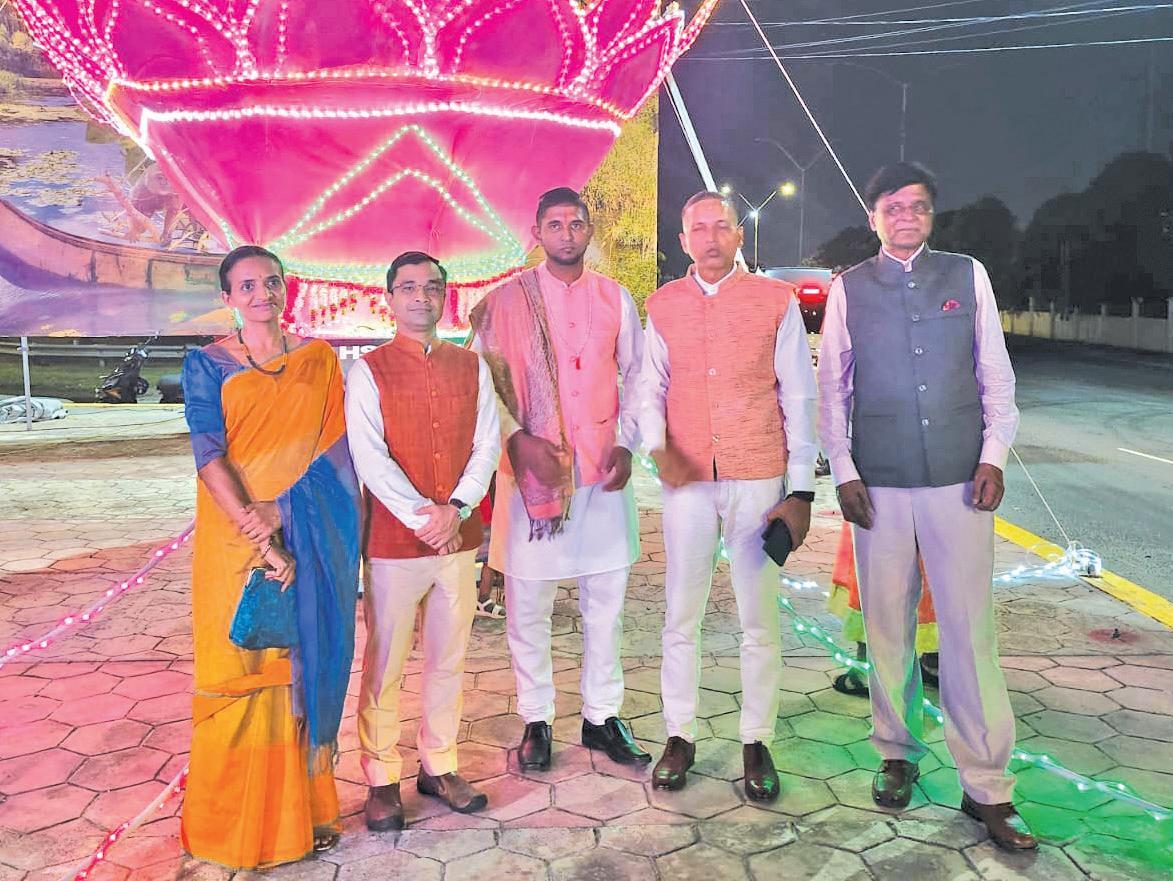
Telang, it is this definition of dharma that is enshrined in the work that the HSS is doing. He added that at the crux of this organisation’s work is the concept of “family” – not the traditional meaning.
“The family we are talking about is one where, in case of any difficulty, in case of any problem, in case of a situation of adversity, the one who comes and stands with you is your family. So, when we talk about a global family, whom do we count upon? Whom do we look for in case of adversity, and also when we celebrate with? Who is it that comes and stands with us?” It is against this backdrop, that High Commissioner Telang
pointed out that Guyana and India are part of the same family. “Guyana and India, we recognise that we are part of the same family, and in case of adversity, we are with each other. And in case of happiness, we share that happiness with each other… Sometimes we tend to believe that the prosperity is your own welfare. If you have to win, then somebody has to lose… This is not that concept. This concept is a win-win concept… That is the concept that we believe in when we talk about a family, and once we start believing in that, all our differences mean nothing, because at the end of the day, we are looking at the welfare of a country as
a whole… So, there is no reason why we should think that in order for Guyana to win or Bharat (India) to win, somebody else has to lose. No, all of us can win. All of us can prosper,” he asserted.
Established in 1996, HSS Guyana, also called Hindus for Selfless Service, is committed to fostering community spirit, selfless service, and cultural values among youth, while promoting unity across Guyana’s diverse society. Through initiatives such as the National Diya, the organisation continues to contribute to national development by encouraging
service to others and celebrating traditions that inspire collective harmony. HSS Member and Indian Rights Activist, Ravi Dev, lauded the work being done by the organisation’s members especially the youth to keep the values and ideals of the HSS intact. “Many of them have kept on against great odds to try to put their shoulders to the wheel to transmit these values and this programme is celebrating Diwali in terms of its essential meaning – the triumph of good over evil.”
“So, in Guyana, this young organisation that was founded by the young people of HSS decided that one of the darkness that must be removed in Guyana are the walls that separate us. And this Diwali light-up, the first in Guyana which started 11 years ago, it would represent in the togetherness of all Guyana,” Dev noted. The National Diya initiative serves as a beacon of hope, unity, and peace, bringing together Guyanese from all walks of life to celebrate the values of love, harmony and cultural pride. Each year, the lighting of the National Diya inspires joy and solidarity, reaffirming the importance of service and community upliftment. Diwali celebrates victory over evil or darkness and the coming of a new year. The light refers to following a path of virtue such that our thoughts are always pure in heart, and the darkness refers to negative thoughts which bring about hurts and sorrow.
In advance of World Standards Day on October 14, the Guyana National Bureau of Standards (GNBS) announced that it will be dedicating the entire week (October 12-18) as National Quality Week (NQW). Standards Bodies worldwide unite to annually observe World Standards Day on October 14, which celebrates the vital role standards play in shaping a safer, smarter, and more sustainable world. According to the GNBS, the theme for this year’s observances: “A shared vision for a better world – spotlight on SDG 17”, focuses on building partnerships, and this will be highlighted during the activities of NQW. The theme was chosen as a collaborative initiative of the International Electrotechnical
Commission (IEC), the International Organisation for Standardisation (ISO) and the International Telecommunication Union (ITU), as the world moves closer to meeting these Sustainable Development Goals (SDGs) by 2030. The United Nations Sustainable Development Goal (UNSDG) 17 becomes more crucial for building partnerships to achieve the other sixteen SDGs, which include reducing poverty and hunger, providing quality education, clean water and sanitation, affordable and clean energy, building industry, innovation and infrastructure, and ensuring responsible production and consumption.
In the field of Standardisation, at all levels people are working together to develop standards which offer solutions and
a shared vision for a better world. As the National Standards Body, the GNBS is proud of the crucial partnerships it has established over the years to promote the use of standards to create a culture of quality in Guyana.
Several of these partnerships were formally established with key stakeholders including consumer groups, business groups and regulatory bodies through the signing of Memoranda of Understanding (MOU), while there continues to be mutual collaboration with others towards advancing our nation. At the international level, GNBS has also signed MOUs with Standard Setting Bodies including American Petroleum Institute (API) and ASTM International which enable access to the latest standards that are
critical to local industries. We also greatly value every opportunity provided outside of these MOUs, especially with other Bureaus in the CARICOM Region, Measurement Institutes and Groupings Worldwide. No doubt, individually and collectively, these partnerships have supported our national efforts to establish a Quality Infrastructure to support the rapid transformation we see today, which also brings Guyana closer to achieving many of the SDGs.
Week’s activities
As customary, during National Quality Week several activities are organised. This year, they include a speech competition for students of secondary schools in Region Two, the dissemination of key messages via the media, a “we are standards”
campaign aimed at enhancing awareness of standards, and the GNBS Long Serving Awards Ceremony to honour our dedicated staff. Additionally, a stakeholder session is slated for the International Business Conference on October 15, and just outside of National Quality Week, in November the GNBS will also host the National Quality Awards 2025, to recognise local businesses that demonstrate outstanding commitment to quality, excellence and continuous improvement.
GNBS welcomes the participation and support of all stakeholders in these activities.
For more information on National Quality Week and standards and services offered by GNBS, call 219 0064-66, WhatsApp 6924627, or visit www.gnbsgy. org.
World Standards Day offers an opportunity to raise awareness and increase understanding of the importance of standardisation. Standards touch almost every part of our daily lives. They ensure that products and services work the way that we expect them to, making life safer and more enjoyable. Standards are essential to achieving the 2030 Agenda and creating a fairer, more sustainable world. This year, World Standards Day will explore how standards provide a shared framework that enables meaningful collaboration across industries, Governments, and organisations to achieve common objectives. The campaign will highlight concrete examples that demonstrate the power of partnership and the impact of working together through standards.

The Guyana Police Force (GPF) is reminding officers that they are legally mandated to act swiftly on reports of domestic abuse and to enforce protection orders under the new Family Violence Act of 2024. Superintendent Shellon Daniels made the call during the latest edition of “Police and You”, a public awareness programme.
She emphasised that the new Act provides greater protection and responsibility for law enforcement when handling domestic violence complaints. “The police are mandated to entertain your report via the telephone or in person,” Daniels said. “They are instruments of authority… signed under the hand and seal of a judge or a Magistrate, commanding the police to do certain things.” Daniels explained that a protection order is not simply a document—it carries the full weight of the law.
“Persons are still of the view that these orders are just pieces of paper with no weight,” she said. “I am going to redefine it. They are instruments of authority that command the police to take certain actions.” She

noted that once a report is made, the police are duty-bound to confront the alleged perpetrator, administer the necessary caution in keeping with the law, and initiate the appropriate process.
“Automatically, the perpetrator will be made aware,” she said. “The police must confront the perpetrator and put the allegation to them, effect that arrest, and commence the process.” The Family Violence Act of 2024, which replaced the Domestic Violence Act of 1996, expands who can apply for a protection order and outlines a detailed procedure for obtaining one. Victims,
or those acting on their behalf, can file an application through any Magistrate’s court, after which the police are required to serve the order on the alleged abuser. Daniels also reminded the public that both temporary and long-term protection orders must be filed at the police station nearest to where the perpetrator resides, so that officers are aware of their existence and can take action if the order is breached. “If it is not communicated to the police, the police would not be in the know,” she cautioned. “It might look as if the police are not taking action.” She further urged the public to recognise that the law empowers officers to enforce these orders decisively.
“Once you secure those orders, take it into the police station closest to where the person resides,” Daniels advised. “The police will take evasive action—and again, the police are mandated to take those actions.” The reminder comes as authorities continue efforts to strengthen accountability, improve public trust, and ensure that victims of domestic violence receive timely protection under the law.
The body of a 41-yearold man, who was reported missing on Saturday, was discovered partially submerged in a koker at Cullen, Region Two (Pomeroon-Supenaam), on Sunday morning. Dead is Heion Vivindra Ramnauth of Lot Z Cullen, Essequibo Coast.
Reports indicate that the incident occurred sometime between 20:30 h on Saturday, October 11, 2025, and 07:30 h Sunday, October 12, 2025, in Cullen village.

According to information received, the deceased resided with his mother, 66-year-old Soorsattie Ramsarup, at the said address. During an interview with Guyana Times, Ramsarup said that her son had been a psychiatric patient for several years and was under routine monthly medical supervision. She explained that due to his condition, Ramnauth would often leave home during the early morning hours to visit the sea -
wall and other nearby locations. On Saturday around 02:30h, Ramsarup reportedly noticed her son missing from his room. After failing to locate him in or around the yard, she filed a missing person report at the Suddie Police Station.
On Sunday, October 12, at approximately 07:30 h, she went to the Cullen koker, where she discovered her son’s body partially submerged and lying face down in the water.
Police were summoned to the scene, and the body was subsequently taken to the Suddie Public Hospital, where Ramnauth was pronounced dead on arrival by a doctor.
The body was then transported to the Suddie Mortuary, awaiting a post-mortem examination. Investigations are ongoing.
A34-year-old security officer was on Friday remanded to prison after being charged with possession of narcotics for the purpose of trafficking.
Carl Blair, of Lot 24 West Ruimveldt Front Road, Georgetown, appeared before Principal Magistrate Faith McGusty at the Georgetown Magistrates' Courts, where he was accused of having 145 grams of cannabis in his possession on October 8, 2025, at West Ruimveldt Front Road. Blair pleaded not guilty to the charge.
When given an opportunity to speak, Blair told the court that on the day in question, he was at a gambling establishment on Front Road where several persons were gathered. He said he had placed his bag on the business’s shutter and, while taking his bag down, another bag fell to the ground. According to Blair, he picked up the bag and began asking who it belonged to when police officers entered the premises. He claimed he was arrested after the officers found the cannabis in his

hand. “This thing happened so fast. As soon as I picked up the bag, I start asking is who bag, within seconds the police come in the place and arrest me”, he said.
The accused told the court that he neither smokes nor drinks and insisted that the drugs did not belong to him. He further claimed that he was being profiled because of his Rastafarian appearance. However, the prosecution objected to bail, arguing that the narcotics were found in Blair’s possession. The Magistrate ruled that Blair’s explanation was not convincing and subsequently refused bail. His next court appearance is on November 7, for continuation.



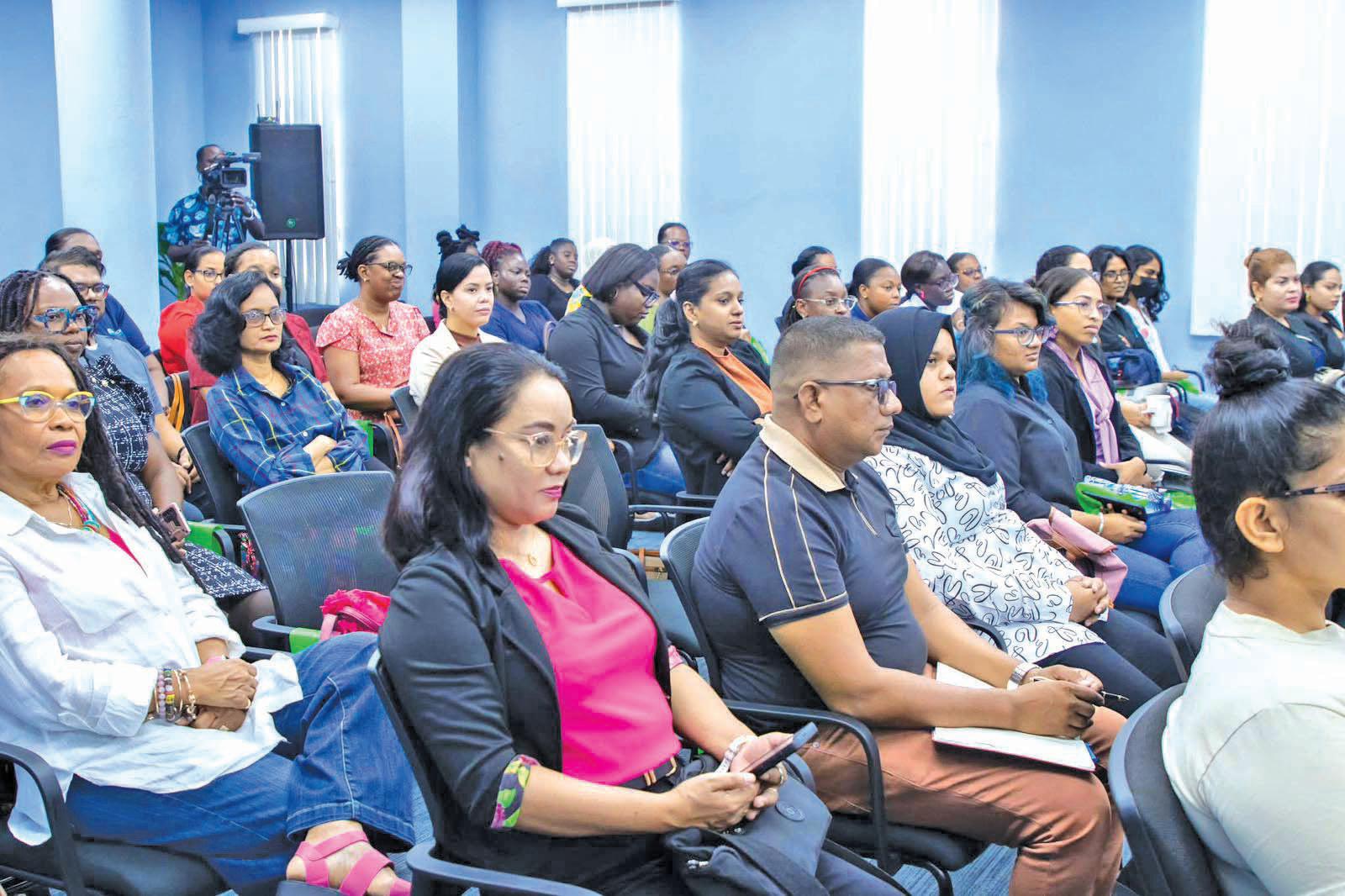
Minister of Health, Dr Frank Anthony on Saturday commended the dedication and contribution of allied health professionals, emphasising their crucial role in patient care and the overall efficiency of the health system. Dr Anthony
made the remarks when he attended the Allied Health Conference, which brought together key stakeholders and professionals from various allied health disciplines to discuss advancements, challenges, and opportunities in strengthening Guyana’s healthcare
delivery system.
In his remarks, Minister Anthony also highlighted the Ministry’s ongoing commitment to continuous education, professional development, and the modernisation of health services across the country. This year’s conference fea-
The Guyana Prison Service (GPS) is putting mental wellness at the heart of its 42nd anniversary celebrations, emphasising that rehabilitation is not only physical but emotional and psychological. Assistant Superintendent of Prisons, Twain Hemerding, said that mental health awareness among officers is a growing priority.
“Today [October 10] being World Mental Health Day, we can’t have the officers just working, working, being burned out,” he said. He explained that activities—ranging from sports to cooking competitions—offer important breaks from the intensity of correctional work, helping staff manage stress and maintain morale.
“So many of them look forward for this activity to come and compete—not really compete rigorously, but just compete in a fun way… relating with their peers after not seeing them for probably six months.” Meanwhile, the Welfare and Corrections Division is ensuring that the same attention is given to inmates.

Tessa McGarrel, who oversees welfare programmes, described how the Service supports the emotional and psychological well-being of those in its care. “We have inmates involved all day in different activities,” she said. “Rather than having them in the cell all day, we bring them out. They do recreational activities… motivational talks among themselves.” She noted that the Service’s mental health initiative goes beyond simple engagement—it includes continuous education, counselling, and medical collaboration. “We also have our medical staff that would go around and let them know about chronic illnesses, how to take care of their mental health, and so on,” McGarrel explained. “We also have our mental health section that would deal with – if we cannot deal with them internally, then we relate with the mental health section for the Georgetown Public Hospital (GPHC) that would address that aspect.” The programme is holistic, ensuring that both men and
women in custody receive attention to their mental and emotional needs. “We ensure that we take care of every aspect of the man and the woman when they are with us,” she added. Assistant Director of Prisons (ag), Olivia Cox, commended these efforts, noting that the Service’s mission is not just to confine but to correct. “Looking back from where we came... to now, we’ve achieved a whole lot,” Cox said. “We’re not just saying that we’re moving from penalty to correction—we’re actually achieving it.” As the GPS continues its journey of transformation, its leadership agrees that mental health care is central to building a safer, more rehabilitative correctional system—one that respects the humanity of every person inside its walls.
tured presentations and research discussions on several key areas of focus such as digital data and health and the health burden of inadequate physical activity and evidence-based benefits of exercise.
In addition, research subjects on Childhood Trauma as a Major Contributor to Anxiety and Depression Among Adults in Guyana; Out-of-Pocket Cost and Determinants of Private Diagnostic Imaging
Services Utilisation on the Essequibo Coast of Guyana; and Arsenic, Lead, and Cadmium in Rice in Latin America and Human Health Risks were also discussed. The conference, according to the Health Ministry, also included an interactive Q&A session, providing participants with an opportunity to engage in meaningful dialogue and share insights on the way forward for the allied health sector.
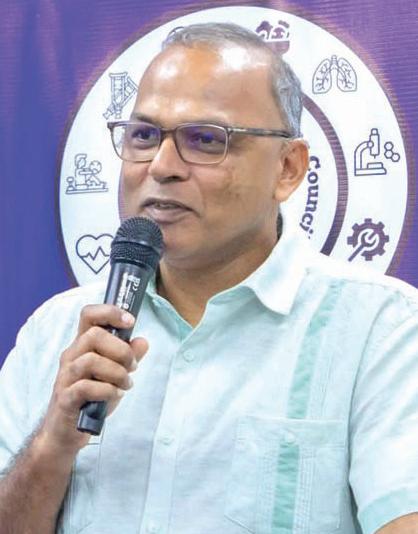
A62-year-old man tragically lost his life on the Essequibo Coast after the derelict wooden house he was living in suddenly collapsed, pinning him underneath.
The dead man has been identified as Fazal Mohomid, a resident of Richmond Village, Region Two (PomeroonSupenaam). Mohomid, a father of two, had been residing alone for several years since the passing of his wife. He occupied a small, weathered structure situated on a plot of land owned by one of his brothers.
His brother, Camo Mohomid, told the publication that he received a call about the incident and immediately rushed to the Lima Regional Hospital,
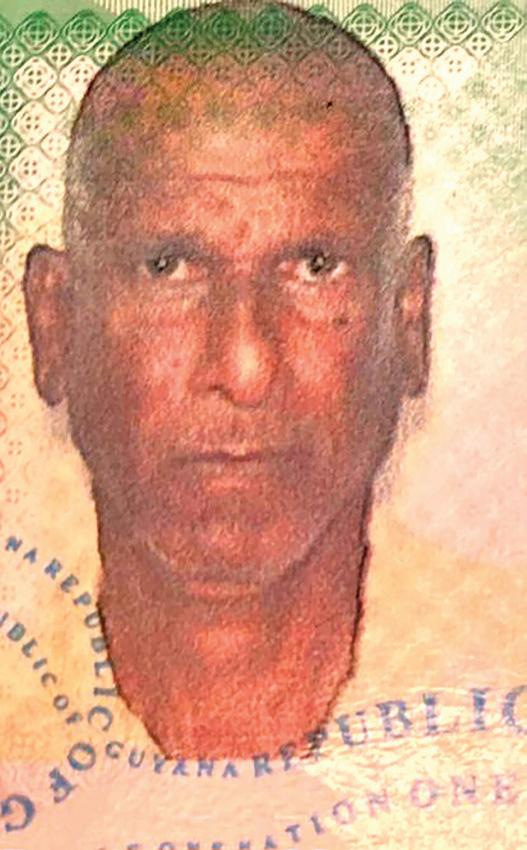
where a doctor confirmed that Fazal had died.
Another brother, Zaheer Mohomid, remembered Fazal as a kind-heart -
ed and helpful individual who was always willing to assist others. He noted that although the family had discussed applying for housing assistance, Fazal’s residence on a family-owned plot meant he did not possess the required documents to qualify for such support. Neighbours recounted that the elderly man had been raking under the house after tying his hammock when the building gave way, collapsing on top of him. They said they had urged him on several occasions to repair the dilapidated structure, but he had declined the offers of help.
Residents of the Richmond community described him as a quiet and humble individual.




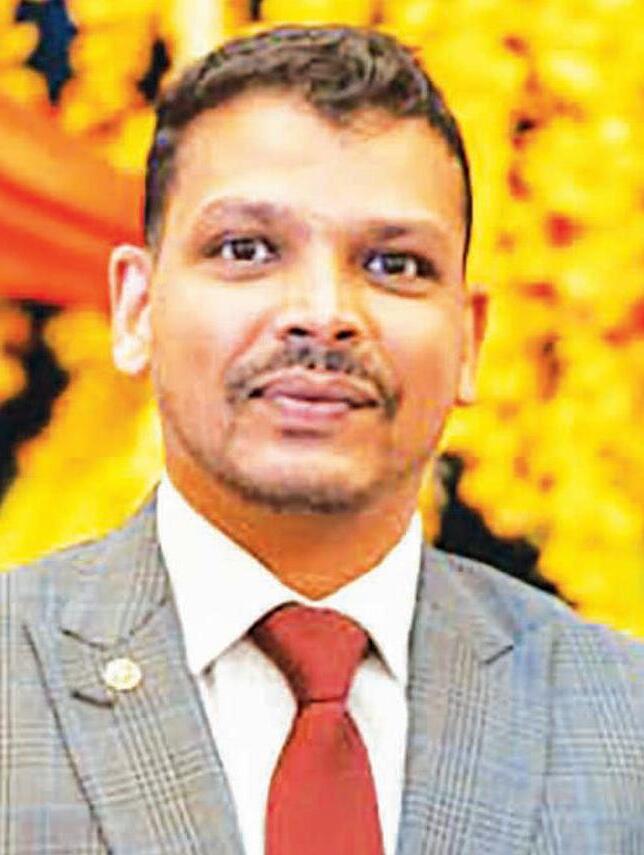
Every year on October 10, the world observes World Mental Health Day
— a time to pause and reflect on one of the most important yet often ignored parts of our well-being: our minds. This year’s theme, “Mental Health Is a Universal Right,” reminds us that just as we all deserve access to clean water, education, and healthcare, we also deserve peace of mind and emotional support.
In every community, there are people silently struggling — the friend who seems quieter lately, the mother who feels overwhelmed, the young man who smiles but feels empty inside. Mental health issues are not a sign of weakness or failure; they
are part of being human.
What is mental health really?
Mental health is not just the absence of mental illness — it’s about how we think, feel, and act each day. It affects how we handle stress, make decisions, relate to others, and find purpose.
Just as we care for our bodies through exercise and healthy food, we must also care for our emotional fitness. The truth is, anyone can experience mental health challenges, regardless of age, status, or profession.
Recognising the signs
Mental health struggles can show up in many ways. Look out for these signs in yourself or others:
• Constant sadness or emptiness
• Withdrawal from family and friends
• Difficulty sleeping or sleeping too much
• Loss of appetite or overeating
• Feeling tired all the time
• Anger, irritability, or mood swings
• Difficulty concentrating
• Feelings of hopelessness, guilt, or worthlessness
Loss of interest in things once enjoyed
When these feelings last more than two weeks or interfere with daily life, it’s important to seek help – just like you would for a fever or chest pain.
Coping and self-care
Taking care of your mental health doesn’t always require a therapist or medication — though those can help. Small, everyday habits make a big difference:
• Talk about your feelings. Sharing your thoughts with someone you trust can lift a heavy burden.
• Stay active. Even a 15-minute walk can boost mood and reduce stress.
• Eat well and stay hydrated. What you put in your body affects how your brain feels.
• Rest. Quality sleep resets the mind and body.
• Pray, meditate, or reflect. Spiritual practices bring inner calm.
• Do something you enjoy. Music, reading, gardening — joy heals.
• Seek professional help. Therapists, doctors, and hotlines are there to help –and it’s a sign of strength to reach out.



Prevention starts with awareness
We can prevent many mental health crises through early support and community care. Parents should talk to children about emotions early, teaching that it’s okay to feel sad or scared. Workplaces should promote wellness — not just productivity.
Faith leaders, teachers, and friends can be great allies in spotting distress.
We must invest in mental health services so that help is available to everyone, not only those who can afford it.
When society treats mental health as part of public health — with empathy, not stigma — we all thrive.
Breaking the silence
Too many people still whisper about depression, anxiety, or suicide as though they are secrets to be hidden. But silence only deepens the pain.
Talking openly about mental health does not make it worse — it saves lives.
If you notice someone struggling, reach out. A simple message like “I’ve noticed you’re quiet — are you okay?” can open a door to healing. Sometimes, being heard is the first step towards recovery.
Moving forward together
Let’s remember: It’s okay not to be okay. Mental health care is health care.
Each of us can be the helping hand someone needs.
Let’s build a Guyana – and a world – where no one has to suffer in silence, where mental health is treated with the same care as physical health, and where everyone knows that help, hope, and healing are possible.
If you or someone you know is struggling, reach out to a trusted friend, health worker, or call a national helpline. Your life matters – and support is closer than you think.

Tcers and inmates can take part in some way.
“We now have a cricket competition, a football competition and a cooking competition,” Hemerding said. “So, who cannot run, but they can cook, we have something for you… We just want all the officers to be a part of any of the event, come out, participate, and build camaraderie among their fellow peers.” Beyond the athletics, other inmate-centred programmes such as poetry, motivational talks, and essay writing aim to encourage self-expression and confidence.
Even the staff would go and have conversations with them.” She said that both inmates and officers benefit from the shared experiences: officers model discipline and empathy, while inmates learn teamwork and responsibility—skills that help prepare them for reintegration into society.
He added that the games foster important values that extend beyond the field.
“Within the sports, you have to have the discipline
he Guyana Prison Service (GPS) is using sport and shared activities to break down barriers and build respect between officers and inmates, fostering discipline and teamwork as part of its 42nd anniversary celebrations under the theme “Changing Culture and Mindsets to Achieve Corrections.” Assistant Superintendent of Prisons, Twain Hemerding, who serves as the Service’s sports officer, explained that the sporting competitions are not merely about recreation, but about shaping better relationships within the prison environment. “Coming out of this competition, we would usually showcase an officer team,” Hemerding said. “Whether it be in the cricket competition or the football competition, that would play within the competition with the inmates. So, they get a chance to not only compete among themselves, but also compete among the officers.”
to participate,” he continued. “So, it builds the respect. It builds the role model effect of the inmates looking up to the officer and seeing a shining example in which they would like to go out and continue being law-abiding citi-
zens.” The month-long observance includes cricket, football, chess, dominoes and other extracurricular competitions across the country’s prison locations.
The Service also introduced a cooking competition this year, ensuring that all offi -
Officer in Charge of Welfare and Corrections, Tessa McGarrel, said these opportunities are designed to bring meaning and purpose to daily life behind bars.
“Rather than having them in the cell all day, we bring them out,” she explained. “They do recreational activities… motivational talks among themselves.
“We are able to bring about that change within them,” added Assistant Director of Prisons (ag), Olivia Cox. “We’re not celebrating prison; we’re celebrating the fact that we are able to bring about that change within them.” The Service hopes that such initiatives, supported by structured sports and social activities, will continue to strengthen relationships and create a culture of respect across Guyana’s correctional institutions. “We are one prison service,” Hemerding said. “We are not at different locations; we are one.”
Observer Online sources have identified the man fatally shot during a confrontation with the police in Kitson Town, St Catherine on Saturday as Bryan King, otherwise called Brico.
King was reportedly the section leader of the Kitson Town-based Klansman Gang, which operates across Kitson Town and the Top Banks area of Spanish Town.
Law enforcement sources describe King as a key figure in organised criminal activities, including contract killings, extortion, and armed robberies.
According to the sources, King rose to prominence in the criminal underworld
after the death of Sheldon “Termite” Walters in 2024, assuming leadership of the Top Banks faction of the Klansman Gang.
He was listed as a person of interest by detectives assigned to the St Catherine North Police Division in connection with a case of shooting with intent against the police. Intelligence reports have also linked him to several murders and violent crimes in the division, including: the October 2024 fatal shooting of Reeshaun Dallas at Nessbry Grove, Kitson Town, on October 31, 2024.
King was also the main suspect in the murder of Kevin Smith at Nessbry Grove, Kitson Town, on July
4, 2024, and the October 2023 killing of Theo Powell also Naseberry Grove.
Police sources say King maintained a network of gunmen who carried out attacks and extortion operations on his behalf, mainly targeting business operators and rival gangs in the area.
His death, the sources say, represents a major blow to organised crime networks operating in and around Spanish Town, particularly those aligned to the Klansman Gang.
King was fatally shot during a confrontation with a police team in Kitson Town about 1:00 pm on Saturday. An illegal firearm was reportedly taken from him.
(Jamaica Observer)
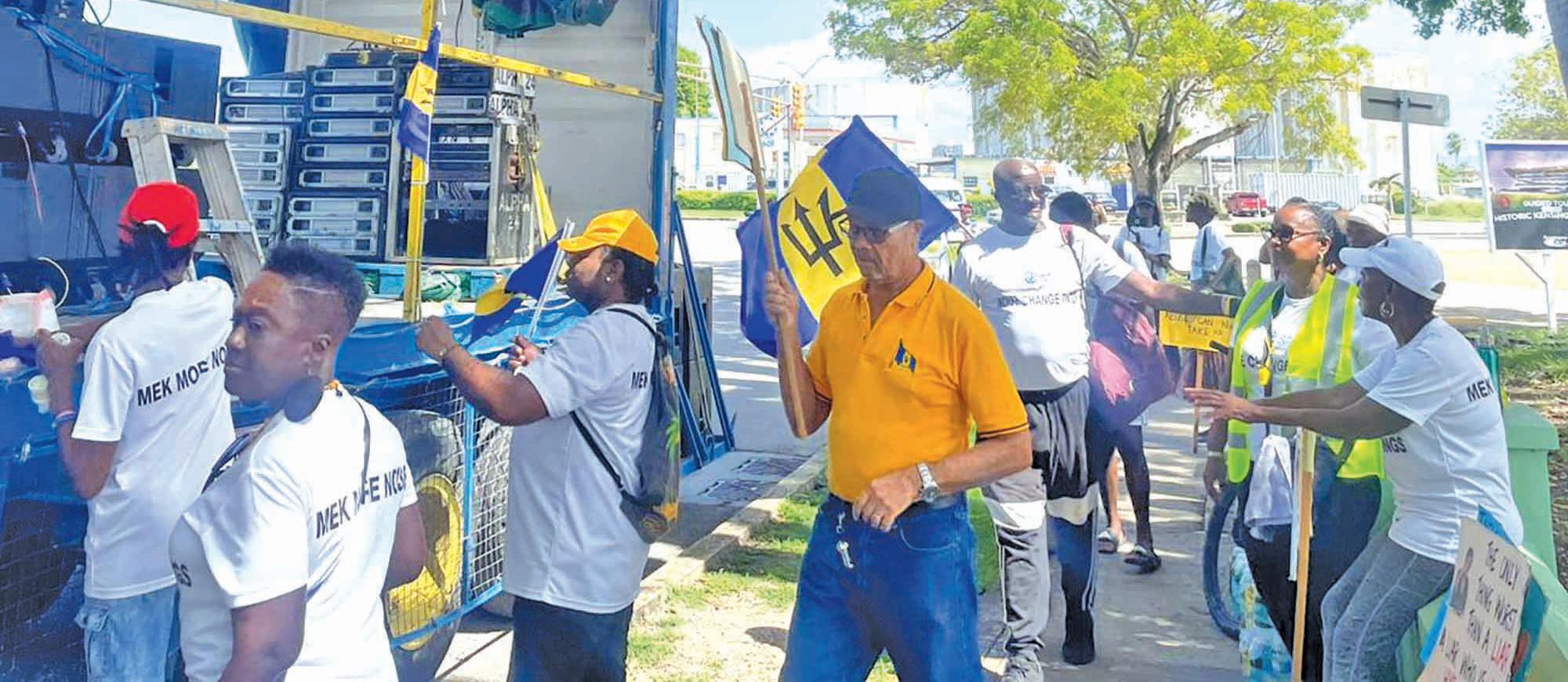
Dozens of Barbadians were back on the streets of Bridgetown on Saturday to protest sections of the proposed immigration and citizenship bills. They insist that, if approved, the laws could have lasting consequences for the island’s identity, resources and democratic integrity.
The demonstration, organised by the Loyal Opposition group, began around 10 a.m. at Kensington Mall, St Michael, where marchers gathered before making their way to Independence Square.
Some protesters blew
whistles and waved the national flag, while others carried placards bearing messages such as “freedom is our right to question everything” and “we do not have a political system, we have an auction”.
Organisers described the action as “peaceful but necessary noise” in their stand against what they called rushed and poorly considered changes to the immigration and citizenship laws of the country.
They expressed particular concern about the proposed citizenship requirements, which the group
argues would make it “too easy to obtain voting rights”, which has political implications.
The Loyal Opposition group made clear that the protest was not about opposing immigrants but about protecting Barbadians and promoting earned citizenship.
Concerns about the bills have also been raised elsewhere, including by Leader of the Opposition Ralph Thorne, KC, who questioned the legality of the new freedom of movement policy, which took effect on October 1. (Barbados Today)
Adispute reportedly over the non-payment of money for vegetables between vendors in Christiana turned deadly on Saturday, with two vendors being stabbed, one fatally, and another in police custody with a head injury.
Police named the deceased vendor as Wrayon Williams, 21, a resident of Harry Watch district in Manchester. A police source told Observer Online that about 5:00 pm, the three vendors were involved in an altercation, allegedly over the non-payment for pak choi, when they got into a fight. One vendor, who reportedly sustained a head injury, allegedly used a knife to inflict stab wounds on two other vendors, including Williams.
The two vendors who sustained stab wounds were rushed to the Percy Junor Hospital, where Williams succumbed to his injuries, and the other vendor was admitted for treatment.
Police later apprehended the third vendor who has reportedly received medical treatment for his head injury. (Jamaica Observer)

Thirty-seven days after he went missing, Chaguanas club owner Imraz Ali’s decomposing body was found down a precipice, wrapped in plastic, off the North Coast Road, Trinidad on Saturday.
Police reported that around midday, acting on information, they went to the location, about a minute’s drive away from the Pillars.
Police believe he was killed not too long after he went missing on September
4, and because he was wrapped in plastic and the cool temperature, his body was preserved enough to make a positive identification. The killers also used duct tape to keep the plastic wrapping in place.
Police said Ali, 60, of Ajodha Road, Cunupia, was last seen leaving a mechanic shop in Freeport, driving a black Nissan X-Trail. It is believed he was carrying a large sum of money at the time to conduct a business deal.
Three days ago, a $100,000 reward was offered for information that could help locate Ali. The reward was posted by Crime Stoppers.
Police said three people are currently in custody assisting with the investigation into his disappearance and now death.
Ali’s recovery came as police reported six murders between Friday night and Saturday morning. (Excerpt from Trinidad & Tobago Guardian)
ADominca Republic (DR) teacher, José Antonio Grullón Polanco, was sentenced to 10 years in prison after being found guilty of harassment and sexual and psychological abuse against 13 students at a high school in the province of Santiago, according to the court composed of three judges.
Grullón Polanco, 45, had previously been transferred from another school due to similar allegations of inappropriate behavior toward students, according to the Public Ministry 's investigation.
The teacher was arrested in 2022 after eight of the victims, aged between 14 and 17, reported the abuse in writing through letters addressed to the school's psychology department.
In their testimonies, the adolescents described being harassed, intimidated, assaulted, and sexually and psychologically abused by the teacher, who used his position of power to manipulate them and subject them to his demands.
During the trial, prosecutors presented documentary and testimonial evidence that confirmed a
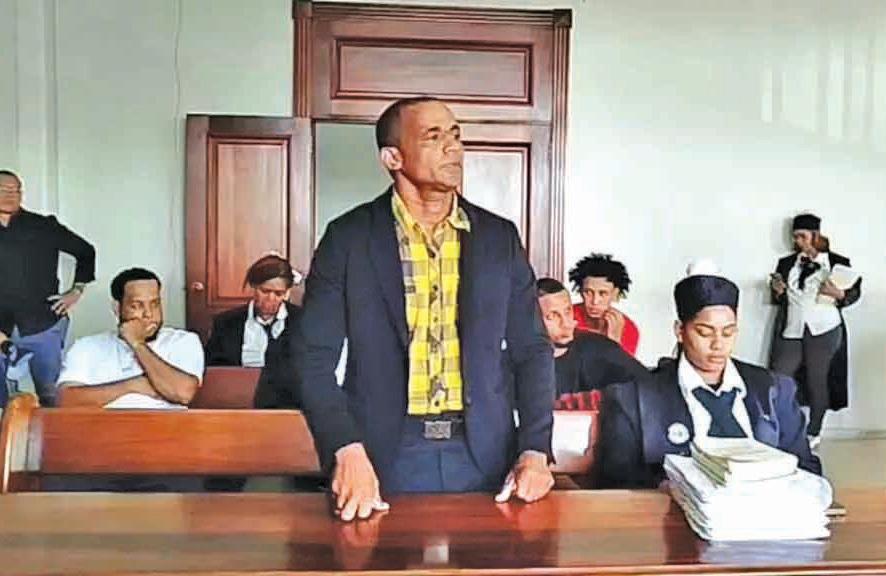
pattern of repeated abuse, known even to other teachers at the school.
In addition to the prison sentence, the court imposed a fine of 100,000 pesos and civil damages of 500,000 pesos on the convicted person and awarded him 500,000 pesos in compensation to the victims.
The sentence comes amid a worrying outlook for gender-based and sexual violence in school settings .
According to the most recent report from the United Nations Children's Fund (UNICEF), 76% of Dominican girls suffer some type of violence before turning 18.
The study, titled "Status of the Situation of the Rights of Children and Adolescents in the Dominican Republic," also indicates that 52.2% of adolescents aged 15 to 17 have been victims of sexual violence. Meanwhile, 45.5% have suffered physical or psychological abuse in school settings.
"These figures reveal an alarming and normalized reality, where violence not only impacts girls' present, but also their future opportunities and emotional stability," UNICEF warned in a statement issued on October 11, marking the International Day of the Girl Child. (Source: El Dia)
Following an armed confrontation between officers from the Rural Mobile Patrol Unit (UMOPAR) and drug traffickers flying a small plane in the community of San Benito, in the Cochabamba municipality of Villa Tunari, three people were arrested and 383 kilos of cocaine hydrochloride were seized.
The crossfire erupted during an intelligence operation tracking a small plane on a clandestine airstrip, when the agents were met with gunfire from the aircraft. Although the suspects attempted to flee, the plane crashed near the runway, facilitating the intervention.

Subjects captured with drugs and weapons
The detainees, Eduardo CV (39 years old), Juan ZG (45) and Sabino RC (55), were arrested after being found in possession of 12 jute bags with 350 packages of drugs, as well as two firearms, a military vest and two vehicles. No one or any police officers were injured in the shooting. The case remains under investigation to determine the source of the controlled substances. (El Diario)

Afederal appeals court on Saturday rejected the Trump administration's request to immediately allow the deployment of National Guard troops to Illinois, leaving in place a lower court's order that blocked the mobilization temporarily.
In a brief order, the 7th US Circuit Court of Appeals said the federal government remains barred from deploying troops but that any outof-state Guard members in Illinois do not need to return to their home states for now. The mobilization had included hundreds of soldiers called up from the Texas National Guard.
US District Judge April Perry had issued an order blocking the National Guard
deployment on Thursday after expressing skepticism about the administration's assertions that the soldiers were needed to protect federal agents from violent protesters.
A separate federal judge in Oregon has also blocked President Donald Trump's effort to send troops to Portland, though another appellate court appeared poised to overrule that decision during arguments earlier this week.
In both cases, the Democratic governors of the states sued Trump, arguing that the administration deliberately miscast mostly peaceful demonstrations as violent to justify further deployments.
Perry's order is set to re-
main in effect until at least October 23, though she could extend it.
Trump has threatened to expand his campaign to other Democratic-led cities, after sending Guard troops this year to Los Angeles and Washington, DC, despite objections from their mayors.
A trial court in Los Angeles ruled the deployment of Guard troops there during the summer was illegal, though an appeals court later granted a stay of that ruling while the administration's appeal is pending.
While the National Guard is part of the US military, during domestic deployments it is usually controlled by governors in response to events such as natural disasters. (Reuters)
Trump "looking at all options" amid threats to invoke Insurrection Act, Vance says
The White House is talking about invoking the Insurrection Act that would allow the deployment of military troops on US soil to quell domestic unrest amid legal challenges over the moves, JD Vance confirmed on Sunday.
Vance was asked on NBC News’s Meet the Press whether Donald Trump was seriously considering invoking the emergency power to deploy national guard forces and even the US military in domestic settings.
“The president’s looking at all of his options,” he said, adding that “we are talking about this because crime has gotten out of control in our cities”.
Trump’s attempts to use
federal national guard forces in Democratic-run cities has faced challenges in the courts, most notably in Chicago in recent days.
The vice-president’s ominous remarks came days after Trump referred to the Insurrection Act from the Oval Office, bluntly stating: “If I had to enact it, I would do that.” Military forces are forbidden from engaging in law enforcement duties on home soil.
But under the Insurrection Act, which was signed in 1807, the president can deploy them domestically in cases of insurrection or rebellion, violence that is preventing the functioning of federal laws.
The power was used during the 1960s civil rights
movement during clashes over desegregation of the south but since then has been very rarely activated. The last time a president called on it was in 1992 when the governor of California requested military aid from George HW Bush in response to civil unrest in Los Angeles.
In Sunday’s Meet the Press interview, Vance said Trump “hasn’t felt he needed to” invoke the Insurrection Act up to this point. But he confirmed that it was among the tactics being considered as the administration continues to be stymied in federal courts from deploying federalised national guard forces in Democraticrun cities. (Excerpt from The Guardian)
The Philippines and China accused each other on Sunday of responsibility for a maritime confrontation near disputed islands in the South China Sea, further escalating tensions in the resource-rich waterway.
The Philippine Maritime Council, an inter-agency government body, blamed Chinese maritime forces for deploying water cannon and ramming a Filipino vessel near the Philippine-occupied Thitu Island, locally known as Pag-asa, "strongly condemning" the incident and vowing to pursue "appropriate diplomatic action".
According to Manila's coast guard, three vessels were anchored near the island early on Sunday as part of a government program to protect local fishermen when Chinese ships reportedly approached and used water can-

non to intimidate them.
An hour later, a Chinese coast guard ship allegedly fired its water cannon directly at a Philippine vessel before ramming its stern, causing minor damage but no injuries, the coast guard said.
China's coast guard said two Philippine government vessels "illegally entered" waters near Sandy Cay, a coral reef in the northern Thitu
Reefs within the Spratly Islands, leading to a collision.
Beijing said a Philippine vessel "dangerously approached" a Chinese coast guard ship, for which it held Manila responsible.
Manila's authorities vowed to continue operations in the area, emphasizing the need to protect Filipino fishermen's livelihood. (Excerpt from Reuters)
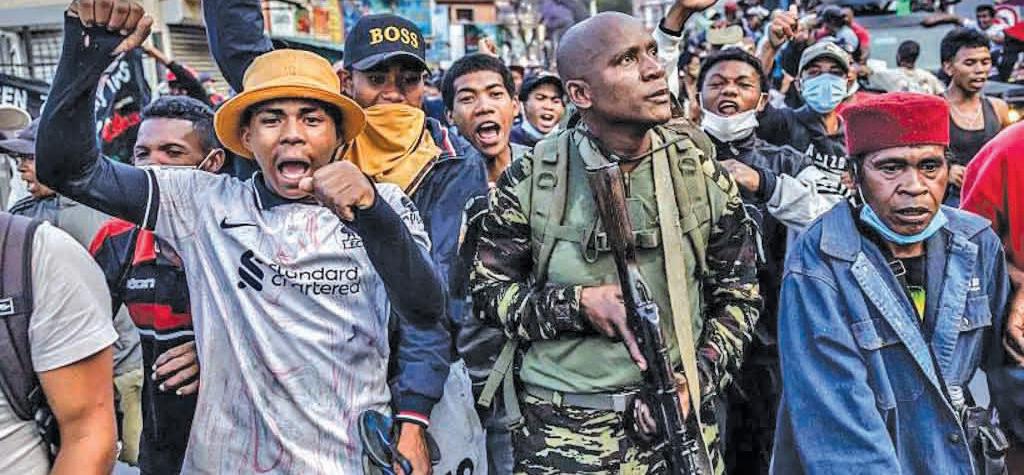
The office of Madagascar's President Andry Rajoelina has said an attempt to seize power illegally and by force is under way in the country.
Hours later, an army unit known as CAPSAT claimed that it had taken over the leadership of the military command, and was now in control of all the armed forces - land, air, and naval.
This is the same unit that played a crucial role in the 2009 Malagasy political crisis, which helped Rajoelina rise to power.
Madagascar was first hit by youth-led protests on 25 September against water and power cuts, but they have escalated to reflect wider dissatisfaction with Rajoelina's government over high unemployment, corruption, and the cost-ofliving crisis.
Rajoelina's whereabouts are unclear, but in a statement he said "there is an attempt to seize power at this time in the territory of the Republic, in complete violation of the Constitution and democratic principles," in a translation.
CAPSAT said it had appointed a new army chief of staff, Gen Demosthene Pikulas, according to a statement issued on its Facebook page.
AFP news agency reports armed forces minister Manantsoa Deramasinjaka Rakotoarivelo has accepted the appointment. (Excerpt from BBC News)
He condemned "in the strongest possible terms" what he called an attempt to destabilise the country. He also called on all of the nation's key forces to unite in defending the constitutional order and national sovereignty.
Amass shooting at a crowded bar on an idyllic South Carolina island has left four people dead and at least 20 injured, officials say.
The shooting occurred early Sunday at Willie’s Bar and Grill on St Helena island, officials said. A large crowd was at the scene when sheriff’s deputies arrived and found sev-
eral people suffering from gunshot wounds.
“Multiple victims and witnesses ran to the nearby businesses and properties seeking shelter from the gun shots,” the Beaufort county sheriff’s office said in a statement on the social media platform X.
Four people were found dead at the scene, and at least 20 other people were injured. Among the in-
jured, four were in critical condition at area hospitals. The victims’ identities were not released.
St Helena island is known as an epicenter of a culture of people descended from African slaves known as Gullah Geechee. The bar and grill where the shooting occurred describes itself as serving authentic Gullah cuisine. (Excerpt from The Guardian)
Defense Secretary Pete Hegseth said Friday the Department of Defense is forming a new counternarcotics joint task force in order to “crush” drug cartels in the Caribbean Sea.
Hegseth said the new task force, established at the direction of President Trump, will operate in the U.S. Southern Command (Southcom) area of responsibility.
“At the President’s direction, the Department of War is establishing a new counter-narcotics
Joint Task Force in the @ SOUTHCOM area of responsibility to crush the cartels, stop the poison and keep America safe,” Hegseth said in a post on the social platform X.
“The message is clear: if you traffic drugs toward our shores, we will stop you cold,” he added.
According to Southcom, the new Joint Task Force (JTF) will integrate the expeditionary capabilities of II Marine Expeditionary Force (II MEF) with Joint Force and U.S. interagency partners, represented
by the Homeland Security Task Force.
“Transnational criminal organizations threaten the security, prosperity, and health of our hemisphere,” said Adm. Alvin Holsey, Commander, SOUTHCOM. “By forming a JTF around II MEF headquarters, we enhance our ability to detect, disrupt, and dismantle illicit trafficking networks faster and at greater depth –together with our U.S. and partner-nation counterparts.” (Source: The Hill, Southcom)










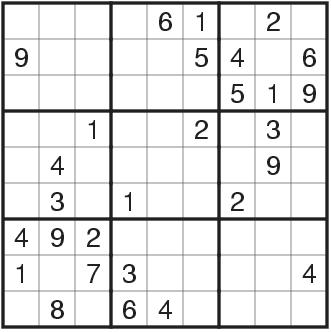





Concentrate on doing what's best for you while taking care of what concerns you most. Your input can lead to progress, new friendships or additional income.
















Domestic changes you implement will bring you closer to people you deal with regularly. A little give and take will go a long way to foster tolerance and reduce prejudice.
A physical change will be uplifting and encourage you to get out and do more. Socializing will lead to interesting encounters and prompt you to rethink how you want to spend your energy.
Think big, but don't overspend in the process. It's crucial to be forward-thinking to accommodate your long-term plans. Don't let denial stand in the way of progress.
Don't let anger set in when realization and courage are your tickets forward. An innovative approach to what works best for you will lead to comfort and joy.
Interact, share ideas and utilize the information you receive to adjust how you live your life. It's time to make changes that suit your needs rather than accommodate others.
Focus on your health, wealth and security, and how you can look, feel and do your best. Change may be calling your name, but clever moves are the key to success.
Forge ahead with a plan. A motivated attitude, alongside intelligence, persistence and relentless courage, will your opponents take a step back.
Proceed with caution. Hidden agendas and false information will put you in a vulnerable position. Ask questions and be aware of what others want before making a commitment.

Overthinking, letting emotions lead the way and taking on too much will be your downfall. You have plenty to gain if you focus on what you do best.




Be a good listener, and you'll gain insight into how to handle people you encounter. A domestic change that lowers overhead and stimulates growth will pay off.

Interacting with others will enhance your ability to grow, reinvent yourself and chart your next steps. It's time to try new things, meet interesting people and stretch your imagination.




Alyssa Healy's epic 142 powered Australia to the highest successful chase in a Women's World Cup, leaving a packed Vizag Stadium thinning very quickly towards the close as hosts India suffered a second successive heartbreak.
Two nights after failing to defend 252 against South Africa, India's decision to play just the five specialist bowlers will be debated long and hard after they failed to defend 330. Australia won with six balls to spare, with three wickets in hand; Ellyse Perry hoisting her Women's Premier League (WPL) team-mate Sneh Rana down the ground to seal victory.
Perry, who remained unbeaten on 47, had suffered a bout of cramps that forced her to retire hurt with Australia cruising at 154 for 1. Then she returned at the fall of Ash Gardner's wicket with Australia needing 32 off 36. When Amanjot Kaur had Sophie Molineux lbw at the start of the 46th over, Australia were seven down.
This is when Kim Garth joined forces with Perry to put on 28 crucial runs off 23 balls to see Australia home. Garth made 14 valuable runs, including a superbly-executed reverse-paddle off Rana in the penultimate over with Australia needing 13 off 11. The win, Australia's third in
them on top of the table halfway through the tournament.
India were eventually left to rue the seven balls they didn't play after a sensational late-order collapse – they lost 9 for 138 in the last 30 overs to finish with 330 when they looked set to scale 350. Unlike Australia, who had Healy go on to convert her start into a maiden century as Captain and third in a World Cup, India could not convert into three figures, with both Smriti Mandhana (80) and Pratika Rawal (75) falling short of three figures.
Except left-arm spinner N Shree Charani, who displayed terrific control and guile to put the brakes on Australia with figures of 3 for 41, the others wilted against Healy's assault in trying conditions. Shree Charani was done by the 39th over, by which time Australia's equation was down to a run a ball. It did not help that Kranti Gaud, full of bristling promise, had a second off day, conceding 73 in nine wicketless overs, while Rana, one of India's form bowlers, went for 85. But the make-up of India's attack meant Harmanpreet Kaur had few alternatives on what was among the best batting surfaces of the tournament.
Australia began cautiously, scoring just 25 off the first five overs before switching gears to ransack 57 in the next five. Healy's fast hands were on display as she took 19 off Gaud's fourth over, while Phoebe Lichfield cracked secutive boundaries off Amanjot fore a missed
run opening stand off just 11.2 overs.
From overs 6.4 to 10 alone, Australia hammered eight fours and two sixes, most from Healy, who dismantled India's spinners with sweeps to every part of the leg side. Perry, scratchy early on, found rhythm alongside her, even resorting to reverse sweeps to unsettle Rana. Their fifty stand came in 55 balls, but India sensed an opening when Perry retired hurt and Beth Mooney and Annabel Sutherland, who celebrated her birthday earlier in the day with a fivefor, fell in quick succession.


executed, yet their recurring collapses would be worrisome for the team management. From 192 for 1 at the 30over mark, they looked set for 370 but fell woefully short, as they failed to capitalise on a superb 155-run opening stand between Mandhana and Rawal.
After three ordinary outings, Mandhana returned to her fluent self, reaching fifty off 46 balls. Her six off Molineux made her the first woman to score 1000 or more One-Day International (ODI) runs in a calendar year, and she later became the fastest to 5000 runs in women's


of providing the late surge yet again fell on Richa Ghosh, whose 94 against South Africa had bailed India out ear -

li er. Here, though, a Sutherland slower ball undid her, triggering a collapse from 310 for 6 to 330 all out.
Sutherland's clever changes of pace and length earned her a maiden ODI five-for and throttled India's momentum, leaving them disappointed at not making the most of the platform they had spectacularly built.
ing briefly spared her. India did not have to wait long, though, as Litchfield
ing Shree Charani to Rana at point

Healy briefly reined herself in before surging to a brilliant century off 84 balls, managing the chase almost single-handedly despite struggling with cramps. Her dismissal off a sliced drive to point was adjudged clean after a tight review that left the stand-in third umpire Kim Cotton in two minds. When
ODIs. While Mandhana took on Molineux, Rawal targeted Gardner, though their partnership was interspersed with spells of caution – like the passage that produced just 15 in five overs after they were 58 for 0 at the 19-over mark.
This was largely down to Rawal's cautiousness. That

she finally felt Rana's hands were underneath the ball, it ended a stunning innings that comprised 21 fours and three sixes. It gave India a fleeting lift, but Perry's return and Garth's composure soon quashed any hopes of a late twist.
India would look back on their batting performance with mixed emotions. They displayed the kind of sustained aggression they've long spoken about but rarely
forced Mandhana to take more risks, producing audacious shots like a ramp over Healy's head. Rawal's 69ball half-century helped post the highest World Cup partnership by any side against Australia before Mandhana fell for 80.
Harleen Deol, Harmanpreet and Jemimah Rodrigues injected urgency unseen so far in this tournament but could not convert their starts. The burden
The loss now leaves India without a win against South Africa, England, New Zealand and Australia at a World Cup (50 overs and T20 included) for five years now. And with England up next in a week in Indore, they'll need to regroup quickly to ensure the run-in to their campaign that was so promising does not leave them exiting their own party before the semi-finals at the very least.
(ESPNcricinfo)


India Women (50 ovs maximum)
Pratika Rawal c Perry
b Sutherland 75
Smriti Mandhana c Litchfield
b Molineux 80
Harleen Deol c Sutherland
b Molineux 38
Harmanpreet Kaur (c) c Molineux
b Schutt 22
Jemimah Rodrigues c Mooney
b Sutherland 33
Richa Ghosh † c sub (G Wareham)
b Sutherland 32
Amanjot Kaur c Molineux
b Gardner 16
Deepti Sharma c Mooney
b Molineux 1
Sneh Rana not out 8
Kranti Gaud c sub (G Wareham)
b Sutherland 1
N Shree Charani
b Sutherland 0
Extras (b 2, lb 4, w 13, pen 5) 24
Total 48.5 Ov (RR: 6.75) 330
Fall of wickets: 1-155 (Smriti Mandhana, 24.3 ov), 2-192 (Pratika Rawal, 30.1 ov), 3-234 (Harmanpreet Kaur, 36.3 ov), 4-240 (Harleen Deol, 37.2 ov), 5-294 (Richa Ghosh, 42.6 ov), 6-309 (Jemimah Rodrigues, 44.5 ov), 7-320 (Deepti Sharma, 46.4 ov), 8-327 (Amanjot Kaur, 47.3 ov), 9-330 (Kranti Gaud, 48.3 ov), 10-330 (Shree Charani, 48.5 ov)
Bowling O-M-R-W
Kim Garth 5-0-35-0
Megan Schutt 6.1-0-37-1
Ashleigh Gardner 7-0-40-1
Berbice put on a commanding all-round performance at the Lusignan Community Centre Ground on Sunday: first bowling out the Select XI cheaply and then racing to the target with overs to spare when the 2025 Guyana Cricket Board (GCB) Queensway Senior Inter-County Super50 Tournament continued.
GCB Select XI won the toss and opted to bat first against the star-studded Berbice squad at the East Coast Demerara (ECD) venue.
Junior Sinclair was a menace with the ball, claiming a five-for in no time.
Sinclair snared 5-25 from 10 overs. Sinclair accounted for much of the Select XI’s middle order as Kwesi Mickle fought to keep his team’s innings together. Mickle top-scored with 49 off 63 balls, but missed out in the half-century after falling victim to Zeynul Ramsammy. The next best score of 16 came off of Joshua Jones’ bat as the Select XI could only manage 139 all out in 37.3 overs.
Supporting Sinclair with the ball was Ramsammy and Clinton Pestano, who both had two scalps each.
Then, in the chase, it was Kevin Sinclair’s time to shine. The all-rounder,
coming in to bat at 27-2 after Berbice lost their openers Adrian Sukwah and Rampertab Ramnauth for 6 and 9 runs respectively.
The batting Sinclair went on to thrill the smattering of spectators at Lusignan with four fours and three sixes in his unbeaten 75 off 63 deliveries. Alongside Ramsammy with an unbeaten 23 off 37 balls, he took Berbice over the line in 29.1 overs for the seven-wicket victory.
Round two of the Senior Inter-County Super50 Tournament will bowl off on Tuesday, October 14 as Demerara take on the GCB Select XI.
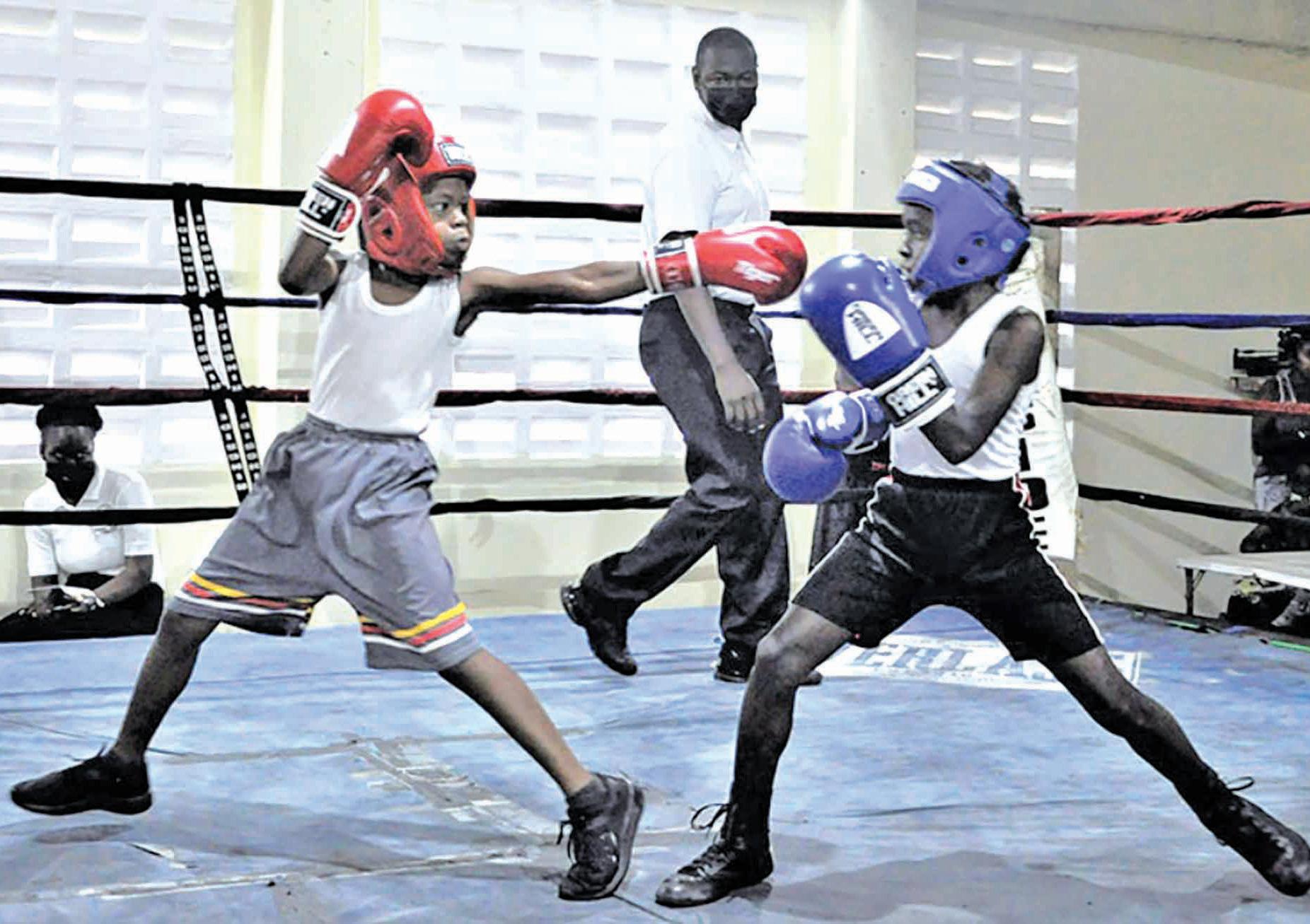
The Guyana Boxing Association (GBA) continued its ongoing developmental efforts with an exciting day of action at the Andrew “Six Head” Lewis Gym on Saturday, as young and emerging pugilists thrilled the audience with skill and determination in the ring.
The event featured a competitive slate of bouts across the Schoolboy, Youth, and Elite categories, showcasing promising talent from clubs such as the National Amateur Boxing Association (NABA), Andrew Lewis Boxing Gym (ALBG), and the Guyana Police Force Boxing Gym (GPFBG).
The tournament formed part of the GBA’s developmental pathway to give
young boxers more opportunities for exposure and experience under competitive conditions. Spectators witnessed technical skill, composure, and grit from several standout performers, underscoring the steady growth of the sport at the grassroots level.
The highlight of the card came from Elite boxer Kevin Isaacs of GPFBG, who won his bout via RSC in the second round and was later named Best Boxer in the Elite category. Among the under-16 competitors, ALBG’s Josh Chester impressed judges and fans alike with his skill and discipline, earning the Best Boxer title in that division.
Below are the results from the tournament:
Bout 1 – Schoolboys: Ukesh Persaud (NABA) v Junior Madray (ALBG) – Madray won by RSC in Rd 1
Bout
2 – Youth: Isiah Nurse (ALBG) v Kurt Mahase (NABA) – Nurse won on points
Bout 3 – Elite: Kevin Isaacs (GPFBG) v Leon Albert (ALBG) – Isaacs won by RSC in Rd.
2
Bout 4 – Elite: Jofes Jackson (NABA) v Oasis Prince (GPFBG) – Coach withdrew boxer from competition
Bout 5 – Elite: Emmanuel Sancho (GPFBG) v Terron Wintz (NABA) – Wintz won on points
Bout 6 – Schoolboys: Josh Chester (ALBG) v Itavius Vanderstoop (ALBG) – Chester won on points
Bout 7 – Youth: Kenny Torres (GPFBG) v Lennox Lawrence (ALBG) – Lawrence won on points
Special Awards: Best Boxer – Elite: Kevin Isaacs (GPFBG)
Best Boxer – U16: Josh Chester (ALBG)


St John the Baptist, West Ruimveldt and Potaro Primary Schools romped to victories on Saturday afternoon to end the group stage of the Courts Optical Pee-Wee Under-11 Schools' Football competition unbeaten when the tournament continued at the Ministry of Education (MoE) Ground, Carifesta Avenue.
Region Seven's St John the Baptist were the first to pick up a win on Saturday, downing Genesis Primary 7-0.
After Aaron Christian got things going with a brace in the 2nd and 8th minutes, Neymar Edeards (17th); Alex Pearson (23rd, 27th); Orlando Deeges (24th) and Jarell Schroeder (25th) added to the score for the massive tally.
A Justin Calvan hat-trick in the 3rd, 19th and 25th minutes later propelled Agatash

margin when they faced off with Charity Primary. Ceon Rajkumar joined the hat-trick club with goals in the 11th, 23rd and 30th minutes, supported by Yanique Cadogan's lone strike in the 21st and an own goal in the 20th.
I-Shent Ouderk (11th) and Rodwell Lindy (13th) netted one goal each in the following
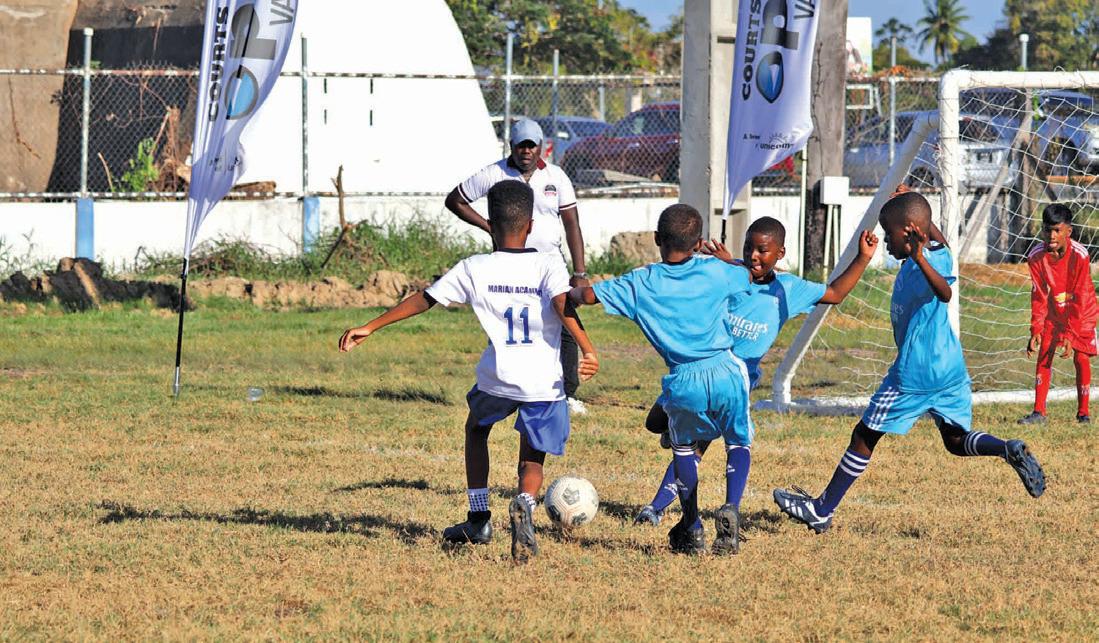
Primary to a 5-0 victory. Carlos Paul, scoring in the 7th and 23rd minutes, then added the finishing touches to their total.
A similar scoreline followed when Stella Maris Primary got the better of Batavia Primary in the following game. Clevon Jacobs was the leading man with goals in the 2nd, 9th and 11th minutes, accompanied by Kenyeatha Junor's brace in the 15th and 35th.
The 5-0 trend seemed to be the hottest of the day as West Ruimveldt Primary brought up their win by the same
game, powering St Theresa's 2-0 victory over Ann's Grove Primary.
Laman Telemaque's lone strike in the 29th minute became the difference between Potaro Primary and Redeemer Primary in a thrilling 1-0 win for the former.
St Gabriel's Primary later secured a 4-0 win against Georgetown International Academy. Nathan Melville scored in the 6th and 9th minutes, followed by goals from Zion Hickerson (25th) and Jalen Simon (27th).
It was a nail-biting encounter between St Pius Primary and Clonbrook
Primary which ended 3-2 in the Georgetown side's favour. Akeem Quintin broke the ice in the 9th minute, but Clonbrook's Jemany Jefford equalised in the 14th minute. Clonbrook took the lead via Wellon Carr in the 23rd, but it was heartbreak for the East Coast outfit as Carlos Waterman's late brace in the 32nd and 34th minutes sealed the win for St Pius.
Smith Memorial later needled Winfer Gardens Primary through a Derick Holder strike in the 13th minute.
Marian Academy brought the curtains down on the day's action with a tense 2-1 win over St Stephen's Primary. Marian Academy's Nwora Lincoln and Lester Thomas secured goals in the 10th and 14th minutes for last year's runners-up.
The Pee-Wee U11 action will continue at the same venue next Saturday as the knockout stages begin.



West Indies made it to the second new ball for the first time this year, they registered their highest partnership for the year – an unbroken 138 between John Campbell and Shai Hope, Campbell became their first half-centurion of the series with a career-best 87, Hope scored his first half-century in 31 innings, but for all that good work they still needed 97 runs to make India bat again in Delhi.
Kuldeep Yadav conjured a fifth Test five-for on a docile pitch to allow India to enforce the follow-on, but the temptation to finish the match early only resulted in hard work for the bowlers: India have now taken four wickets in their last 75.2 overs.
India were not in immediate danger of falling behind in the Test, but they will question if they had been complacent in enforcing the follow-on: when you do so midway into the third day, having bowled 81.5 overs already, there must be an element of expecting the opposition to roll over. India were then left riding two boats: trying to get the wickets, but also preserving their bowlers, which meant Jasprit Bumrah did not bowl in the first 32 overs of the second innings.
Overall, though, eight wickets in a day on this Delhi pitch was not an ordinary effort. It was mainly down to Kuldeep, who overcame the lack of spite in the surface with work in the air and keeping the stumps in play. Four of his five wickets were either bowled or lbw, exposing both edges with drift and subtle chang-
the off stump of Hope in the seventh over of the day. In the first Test, he beat Hope's inside edge to bowl him,
aware threat, but it cemented his feet, resulting in playing a full ball away from the body, playing it on to give a fast bowler a wicket for the first time
Now, at 175 for 8, began West Indies' resistance. Khary Pierre and Anderson Phillip batted together for 16.5 overs, taking West Indies to lunch
partnerships. Having still decided to continue bowling, India opened with Siraj and Ravindra Jadeja. Bumrah, who had bowled eight overs already, would be the last bowler employed (discounting Yashasvi Jaiswal, who was handed the final over of the day). The fields India used did not seem to suggest they believed there was enough in the pitch to produce wickets.


ter on this tour. Campbell and Hope then began to frustrate India.

but this slow pitch needed something more. The drift from Kuldeep took the ball away from the original expected line, and then the ball did not turn as much as expected. Pretty soon, Tevin Imlach was beaten on the inside edge by a rare delivery that turned sharply. Justin Greaves contributed to his own dismissal with an ungainly reverse-sweep, which he missed by some distance. Kuldeep was on target again.
At the other end, Bumrah first and then Mohammed Siraj had been looking to hit the front pad of the batters. Jomel Warrican was

and beyond. Bumrah had to
feating him with his drift. On two occasions, Campbell was hit on the pad before the bat, but on both occasions the umpire's call on the impact saved him from the lbw.
It still seemed to be go-


his fifth wicket, including bowling with the new ball. He eventually got the fifth, but not before the last wicket had batted nine overs together.
If there had been any doubts about enforcing the follow-on, they must have only grown with these two
runs. Siraj got Tagenarine Chanderpaul on the pull for the second time in the series. Washington Sundar then produced the ball of the day, drifting it in from wide on the crease and then turning away to bowl Alick Athanaze, who has looked like West Indies' best bat-
Campbell, who was out to a freak catch that just stuck in the short leg fielder's arms in the first innings, arguably deserved some of the luck he enjoyed against Washington, who kept de-
With no zip in the pitch, the duo defended well and kept bringing out the big hit every now and then. Campbell showed particular intent against Jadeja and Kuldeep. The latter went for 36 in his first six overs. It was clear West Indies did not want to let Kuldeep settle. Campbell swept him for a six and lofted him down the ground for a four in his first over to bring up his fifty. Hope relied more on his touch play, the kind we are used to in One-Day Internationals (ODIs), although he did get going with a slog-swept six off Washington. Errors in length began to creep in soon, fielding grew lethargic with bowlers misfielding off their own bowling, and India even conceded a no-ball for having too many fielders behind square on the leg side. Jaiswal ended the day with friendly legbreaks as West Indies won a session for the first time in the series. (ESPNcricinfo)





Federation (GFF) Women's Division One League continued at the National Training Centre (NTC), Providence, East Bank Demerara on Friday night.
Western Tigers were the first to pick up their three points on the back of a team effort. Akilha Roberts was the first to strike for Western, finding the back of the net in the 18th minute.
However, their opponents, Ann's Grove United were relentless after the deficit and their advance paid off in the 23rd minute, when a curling shot off the boots of Monica Roberts found the back of the net.
Western reclaimed their lead just before the half as Chelsy Lupe and Marissa Frank netted in the 28th and 30th minutes respectively for a 3-1 score at halftime.
Ann's Grove tightened their defences in the second segment, but were unlucky at the other end of the pitch, resulting in the final score remaining 3-1.
Then, Rivers' View put on a shooting masterclass to fend off an advancing Monedderlust FC in the following encounter.
Nickesha Persaud gave the Region Seven outfit an early lead, finding the back of the net in the 5th minute, but Monedderlust levelled the scores when Sasha Leo enjoyed a breakaway run to slip the ball into the left corner of the net in the 21st minute.
Before the half expired, Aleya Daniels made use of a weak clearance, sending the rebound back into the left corner of the goal for a 2-1 lead at the half.
In the second half, Persaud completed her brace in the 34th minute, but it was Daniels with her signature
right-footed rifle shot that found the net in the 39th and 54th minutes to seal Rivers' View's 5-1 victory. The Women's Division One League will continue on Wednesday, October 15 with another double-header.
At 18:00h, Den Amstel battle Santos FC while at 19:30h, Mainstay Goldstar take on Guyana Police Force (GPF) Women.
The 10 teams are competing in the League for a historic $1 million grand prize.

